Helleristninger
300 Scandinavian petroglyph sites and the 3 artists who engraved them
Allan Krill, Professor of Geology
Trondheim, Norway
(30 minute audio, December 25, 2024)
In June 2021, while looking at the Alta petroglyphs (helleristninger) with my geology students, I realized that those engravings could not have been pecked with Stone Age tools. Stone points are brittle and shatter when struck. We can see that the pecking tool was as sharp as a nail and could be accurately positioned and hammered. The point kept its shape without breaking, strike after strike. A boat nail would be ideal. I hypothesized that the Alta petroglyphs were made with iron boat nails in the Iron Age, not with stones in the Stone Age.
Nailpoint marks are clearly visible at Alta.

Left: Longship with animal-head prow and a crew of 15 or 30 men.
Center: Cervid (reindeer, moose, or elk.)
Right: 'Bronze Age'-style boat, and 10,000 year old glacial striations.
Some of the petroglyph images are Viking-style longships with animal-head prows and large crews. Such boats are for long-distance travel, not for fishing. It would probably take about two weeks for a crew to paddle the full length of Norway. There would always be a hammer and spare nails on a longship for necessary repairs. A petroglyph artist who was a strong paddler would be welcome to join such trips. People with longships would not spend winters in arctic Alta, where the sun sets on November 24th and doesn't rise again until January 16th. They probably visited Alta in the midnight-sun season, like I do. Some images among Alta petroglyphs suggest that Smi people kept domesticated reindeer in corrals, and the visitors were obtaining reindeer skins from them.
I have studied photographs and tracings of petroglyph images and tried to recognize individual artists by their quirks. I now think that only three artists Ñwhom I call Steinn Stikkmann, Ingi Innrisser, and Oddr OmrisserÑ made nearly all the petroglyphs in Norway, Sweden, and northwest Russia. There are no pecked petroglyphs in Finland, and none in large parts of Sweden, or in Aust-Agder Norway. In my paradigm, that is because none of the three petroglyph artists visited those places.Ê
I think that Steinn Stikkmann invented the nailpoint technique, and Innrisser and Omrisser got the idea from him. There are runes at eight of Stikkmann's sites Ñat Stuberg, Ytter¿ya, Tessem, Krstad, Myklestad Tysnes, Askum, Herrestad, and Himmelstalund. The runes are mostly undeciphered, and some may have been meaningless, but they show characters of the Elder Futhark alphabet, which was in use about 400 CE. Swastikas from the same general time are engraved at several of his sites Ñat Stuberg, Inder¿ya, Krstad, ¯ygarden, Askum, Svarteborg, and Tossene. The runes give us the age of Stikkmann's petroglyphs. All three artists sometimes showed longships with animal-head prows, which were precursors of Viking dragon-head prows. But since none of the petroglyph boats show sails, all the petroglyphs must have been made before 800 CE. I hypothesize that Stikkmann lived about 400 CE and Innrisser and Omrisser sometime between 400 and 600 CE.
The links below explain my evidence and hypotheses (including hypotheses that I have abandoned).
303. Archaeologists have never found chips from supposed stone pecking tools
(6/2025)
302. Steinn Stikkmann visited Tj¿tta, north NorwayÕs main pre-Viking settlement
(6/2025)
301. Steinn Stikkmann left boats, cup marks, and runes on Ytter¿ya
(6/2025)
300. Map of Steinn Stikkmann's travels
(6/2025)
298/299. Fluky site locations: Absence of evidence is evidence of absence
(5/2025)
297. I now know of runes at six of Steinn StikkmannÕs petroglyph sites
(5/2025)
294. Differing mindsets in geology and archaeology
(5/2025)
293/296. Steinn Stikkmann's sites in eastern and southern Sweden
(5/2025)
290. Rennebu and Gravem petroglyphs show that Stikkmann began his long journey on foot
289. Steinn Stikkmann left his mark on the island Bornholm
(4/2025)
287. "Same ship, different day"
(4/2025)
286. Mostly cup marks on Orust, because there is no Bohus Granite there
(4/2025)
285. Percentages of StikkmannÕs figures at sites in Bohusln, and at Lista, Leirfall, & Foss
284. Steinn Stikkmann made a U-turn at the southern tip of Norway
(4/2025)
283. Only three traveling artists (not four)
(4/2025)
282. Steinn Stikkmann loved engraving cup marks
(4/2025)
281. Sites in Bohusln with swastikas and Elder Futhark runes by Steinn Stikkmann
(4/2025)
279. The maypole (majstngen) of Tanum was probably not engraved by Steinn Stikkmann
278. StikkmannÕs art at Kivik is from about 400 CE, but the monument is probably older
277. Tryggvi Tagger probably learned nailpoint technique from Stikkmann at B¿rve
276. Innrisser and Omrisser were together at Glemmestad (2/2025)
275. StikkmannÕs phalluses were about masculinity and power, not fertility (2/2025)
274. Innrisser and Omrisser were together at Ekeberg, Oslo (2/2025)
273. Innrisser and Omrisser were together at Salthammeren, Hardangerfjord (2/2025)
272. Petroglyph sites record StikkmannÕs journey from Bergen to Stavanger to Telemark
271. Four traveling graffiti artists and one traveling graffiti tagger (2/2025)
270. Petroglyph sites show how Stikkmann traveled from Skien to the Bohus Granite
269. At Bardal, InnrisserÕs deer got humps and bigger heads (2/2025)
268. How Innrisser's deer (finally) got their humps (2/2025)
267. At Selbustrand, I imagine Stikkmann thinking: 'These boulders are like from heaven!'
264. Innrisser and Omrisser were together on the island Langnesholmen in Altafjorden
263. Ingi InnrisserÕs early styles of drawing humans at Vingen, Storsteinen, and Amtmannsnes
262. Ingi InnrisserÕs birthplace was probably Skatestraumen near Vingen (1/2025)
261. InnrisserÕs powerful animal-head sticks (Alta, Vingen, and Nmforsen) (1/2025)
258. Oddr OmrisserÕs birthplace was probably between Strmsund and Nmforsen, Sweden
257/259. Porpoise images show that Omrisser visited Tennes early in his career (1/2025)
256. StikkmannÕs birthplace was probably Foss in Gauldalen, central Norway (1/2025)
ResearchGate PDF with links to 220 petroglyph sites (12/2024)
220/252.
Elder Futhark runes (c. 400 AD) at Stuberg, Tessem, & Krstad, by Stikkmann
248/249/250. Stikkmann preferred Iddefjord (Bohus) Granite panels for his petroglyphs
247. Petroglyphs in Skien, tracings by Marstrander (1969) (12/2024)
246. Examples (2) of petroglyphs from the book 'Hllristningar och Kultbruk'
245. Examples of petroglyphs from the book 'Hllristningar och Kultbruk' by Almgren (1927)
244. Stikkmann's petroglyphs date the Kivik King's Grave to about 400 CE (12/2024)
242. Petroglyphs of supposed 'Bronze Age boats' are all from the Iron Age (12/2024)
241. Distinctive images: Another huge Stikkmann longship discovered this month (11/2024)
238.
Ingi Innrisser could have made all the '¯stnorske veideristninger' in a single summer
237.
Distinctive images: Outlines of bears, by Oddr Omrisser (11/2024)
236. Alphabetical list of petroglyph sites and artists (11/2024)
235.
The rock art painting motifs in Finland are very different than those in northern Sweden
234.
Ramqvist map shows limited motifs of ocher petroglyphs in northern Sweden (11/2024)
233.
Map from Jamtli.com of all known ocher-paint petroglyph sites in northern Sweden
232.
Ocher-paint petroglyphs in Mid-Norway (11/2024)
231.
Distinctive images: Porpoises, by Oddr Omrisser (11/2024)
230/239.
Omrisser made ocher paintings in Sweden in winter, standing on ice-covered lakes
226/227/228/229.
Did Innrisser carve the 'Surnadal man' before or after the 'Ausevik men'?
225.
Stikkmann traveled to ¯stfold-Bohusln via Sporaneset, missing Aust-Agder (11/2024)
224.
Maps of Brdr Btmann's sites in Stavanger and SW Norway, from Fett & Fett (1941)
223.
Oddr OmrisserÕs sites and works in Mid Norway and Sweden (11/2024)
222.
Stikkmann, Btmann, Innrisser & Omrisser were 'pre-Viking Banksys'
221.
Distinctive images: A big fish (by Omrisser) on top of petroglyphs at Alta and Stavanger
219.
How could one artist produce petroglyphs at 2700 sites in the ¯stfold-Bohusln area?
216.
Distinctive images: Deer looking back, by Oddr Omrisser (11/2024)
214/217.
Distinctive images: A few 'giants' on a longship, by Steinn Stikkmann (11/2024)
213/215.
Distinctive images: Complex scenes, by Ingi Innrisser (10/2024)
212/260.
Distinctive images: Large, naturalistic animals, by Oddr Omrisser (10/2024)
211.
Distinctive images: Chariot pulled by 2 thin horses, by Steinn Stikkmann (10/2024)
209.
Distinctive images: Isolated deer head, by Oddr Omrisser (10/2024)
208.
Distinctive images: Man approaching tiny woman from behind, by Oddr Omrisser
207.
Distinctive images: Rhombs with 3D effect, by Oddr Omrisser (10/2024)
206/243.
Distinctive images: Processions, by Steinn Stikkmann (10/2024)
204.
Map of sites where 4 petroglyph artists worked, and 3 areas with no known petroglyphs
199.
Petroglyphs tell about the 'Pre-Viking Age' in Scandinavia (10/2024)
198.
Photos from B¿e (1932) show that a sharp point was used to peck Vingen petroglyphs
197.
'Omrisser' (Outliner) never visited Vingen (10/2024)
196.
All the helleristninger at Vingen were made by one visiting artist: 'Innrisser'
(10/2024)
195.
'Inliner' may have used boat nails from Slettnes III at Slettnes IV (5/2024) 194.
Inliner's work now recognized on boulders at Slettnes (5/2024)
193. Stickman (the first) and Outliner (the last) of the great petroglyph artists (12/2023)
191. Lecture on Stickman and Outliner (20 figures) (11/2023) (Video) Lecture
on Stickman and Outliner (first 40 seconds in Norwegian) 190.
Map of 90 petroglyph sites and typology used to identify 7 artists (10/2023) 181.
Red-ochre painting at Tingvoll and at Fngsjn: a fourth
technique used by Outliner 178.
Map of 90 sites where petroglyph artists worked, and 3 areas where none are
known 173.
Stickman may have made all of the petroglyphs in the ¯stfold-Bohusln
area (8/2023) 172.
Why are there no known petroglyph sites in Aust-Agder? (8/2023) 171.
Outliner's large humans at Alta, Bardal, B¿la, Evenhus, Forselv, and Lnke (8/2023) 170.
Futhark runes and a swastika independently date the Krstad
petroglyphs to 400 AD 165.
Krstad petroglyphs (200-500 AD) show runes and
Hjortspring-style boats (7/2023) 163.
Outliner learned to draw longships at Stavanger and then drew them at Alta 161.
At Bogge, chasing after petroglyph artists (7/2023) 158.
Longship and boat petroglyphs at Apana grd Alta (7/2023) 155.
Matching images at 9 and 23 meters above sea level at Alta (7/2023) 121/154.
Lumpers and splitters: I am a lumper, whereas archaeologists have refused to lump 152.
Who made the longships of Iron-Age-style at Apana,
Alta? (7/2023) 148.
Learn to recognize Outliner's boats
(7/2023) 147.
"...depictions comparable to the South Scandinavian Bronze Age and
Iron Age boats" 146.
Bergbukten 1 (Alta): two artworks for the price of
one (7/2023) 141/145.
Inliner's 'nailpoint' reindeer at Apana grd (8-10 m. above present sea level) (7/2023) 144.
The famous petroglyph 'Man on skis' was probably a man standing in
a boat 143.
Two 'owners' of reindeer at Bergbukten 4B Alta ('Inliner' and 'Outliner') (7/2023) 142.
Animal-head sticks and animal-head boats in Alta petroglyphs (7/2023) 140/149/153. Map of six petroglyph artists
and sites where they worked (3) (7/2023) 139.
Amtmann Ñ another petroglyph artist that can be recognized at
Alta (7/2023) 137/138. A few hours' work by Outliner at Kfjord, Alta (2)
(7/2023) 136/150.
Outliner carved petroglyphs on top of previous artworks at Bogge, Bardal, Alta 133. Outliner's petroglyphs are easy to recognize, and
found only in the north (2) (7/2023) 132.
Stykket is an example of 'distressed' art by Outliner (7/2023) 131. Petroglyphs at Leiknes:
rock art from one year, or from five hundred years? (2) (7/2023) 130.
Petroglyphs at Alta that I ascribe to Outliner and Inliner
(tracings in the book by Helskog) 128.
Some petroglyph moose at Alta that I ascribe to Outliner and Inliner (7/2023) 126.
Some petroglyphs in central Scandianvia that I
ascribe to Outliner and Inliner (7/2023) 124.
Outliner's petroglyphs are easy to recognize, and found only in the north (7/2023) 123.
Outliner drew 'bulging' eyes at Brennholtet and Leiknes, and unique mouth lines (7/2023) 122.
Iron longship nails were ideal for making 'nailpoint'
petroglyphs (7/2023) 120.
Photos taken at Tennes (Grberget,
Balsfjord) in northern Norway (6/2023) 118.
Photos taken at Tennes (Kirkely,
Balsfjord) in northern Norway (6/2023) 117.
Photos taken at Tennes (Bukkhammaren,
Balsfjord) in northern Norway (6/2023) 116.
Petroglyphs at Leiknes: rock art from one year, or
from five hundred years? (6/2023) 115.
No petroglyphs or Viking artifacts have been found in Finland (6/2023) 114.
Outliner's nailpoint art at the Ole Pedersen site, Hjemmeluft, Alta
(6/2023)
113. Why my manuscripts were rejected by the journals ÔVikingÕ and ÔPrimitive Tider
(6/2023) 112.
Stickman's early showpiece at Leirfall is currently
closed to the public (6/2023) 109.
Outliner's elegant pose: deer looking backward (6/2023) 108.
Close-up photos of Inliner's 'nailpoint
art' at the Ole Pedersen site, Hjemmeluft, Alta 106.
Map of five petroglyph artists and sites where they worked (6/2023) 103.
Outliner 'scraped' his petroglyphs in Nordland (he
did not 'polish' them) (6/2023) 102.
Ismo Luukkonen shows
petroglyphs of 83 Scandinavian sites for you to study at home 101.
Outliner's reindeer and moose at Fykanvatnet, near Glomfjord (6/2023) 100.
Outliner's scraped moose petroglyph at Mj¿nes (Vgan) (6/2023) 99.
Outliner's reindeer and man at B¿la, near Steinkjer (6/2023) 98.
Outliner's 'design-signature' at Hell (near Stj¿rdal) and Forselv (near Narvik) (6/2023) 97.
Inliner's 'nailpoint art'
at Kfjord, Alta
(6/2023) 96.
Outliner's 'nailpoint art' in a one-man show at Apanes, Alta (6/2023) 95.
No petroglyphs are found in suitable rocks near the shorelines (why not?) (6/2023) 93.
Map of three main petroglyph artists
(6/2023) 92.
It was typical of Outliner to ignore the feet (5/2023) 91.
Alta - Kfjord petroglyphs seem to show early Smi
culture and early Viking culture 89.
Distinguishing between Inliner's work and Outliner's
work at Alta (5/2023) 87 & 88. Outliner drew collars on some of his reindeer
(2) (5/2023) 86.
A boat with a square sail (5/2023) 85.
Smi people lived with domesticated reindeer also before Viking times (5/2023) 84.
Stickman trained in soft sedimentary rocks in the Stj¿rdal
area (5/2023) 82.
Outliner used three different techniques to outline bodies and body parts (5/2023) 81.
Three artists made nearly all the petroglyphs around Trondheimsfjorden (5/2023) 80.
Runes and petroglyphs at Ystines / Ydstines near Stj¿rdal (5/2023) 79.
Petroglyph artists probably spoke a Scandinavian language (5/2023) 78.
Inliner probably traveled to Ekeberg
(Oslo) by boat, not by foot (5/2023) 77.
Artist's names are not set in stone
(5/2023) 76.
Digital caliper: a new tool for describing petroglyphs (5/2023) 75.
A paradigm for Scandinavian petroglyphs (manuscript to journal Primitive Tider) (5/2023) 66.
Shoe prints. Artists often learn or copy from others (2/2023) 64.
Names of places where petroglyph artists exhibited their work (2/2023) 62.
Five petroglyph artists recognized by their motifs and artistic styles (manus. in prep) 61.
An alternative interpretation of some petroglyphs in Finnmark (manus. to journal Viking) 59.
Boats with animal heads among petroglyphs at Peterborough Canada (1/2023) 56.
Vikings visited many coasts and rivers in their longships (1/2023) 55.
Petroglyphs in Peterborough Canada, probably made by a Viking artist (1/2023) 53.
"Shoreline dates" are not really dates at all. Better to call them
"Shore maximum ages" 52.
Hard rocks can't be engraved using stone-age tools. Most Scandinavian
rocks are hard. 51.
A simple explanation for petroglyph cup marks (12/2022) 45-49. 'Iron-age Banksys': how
widely did they spread their wall-art? (5) (11/2022) 44.
Most petroglyphs were made within sight and shouting distance of the shoreline (11/2022) 43.
Petroglyph shoreline dates should be referred to as Çshore-limiting datesÈ (11/2022) 42.
Lichen grows on all exposed rocks in Norway (11/2022) 39.
Shoreline dating improperly used to date Vyg whale
hunting (11/2022) 38.
Petroglyph evidence for cultural exchange between Vikings and Smi (11/2022) 36.
Nmforsen petroglyphs supposedly show a 4000-year
spread of carvings (7/2023) 34.
Petroglyph artists (300-800 AD) were Scandinavian and did not visit Finland (11/2022) 33.
What does this strange petroglyph really show? (11/2022) 32.
Spoiler alert: my musings kill good stories and eliminate fun puzzles (11/2022) 31.
Arctic summer hunting trips, destination Alta (11/2022) 30.
The Gamnes petroglyph and knapped-flint site can be
no older than 1700 years 29.
See how flint arrowheads are knapped (Youtube) (11/2022) 27. Newly discovered petroglyphs at 26 m show shoreline-dating
gives us falsely old ages 26. Grahame Clark (1975): The Earlier Stone Age Settlement of
Scandinavia (11/2022) 24.
How 'shoreline dating' has been used for Alta petroglyphs (11/2022) 21.
A petroglyph of a longship with an animal-head prow nails its age (11/2022) 20.
Biases maximize the age and archaeological value of Leirfall
petroglyphs (11/2022) 19.
The Professor's Old Claims (12/2022) 17.
A Viking-age neck ring (torc) brought to Alta and
abandoned there (11/2022) 16.
Why Alta petroglyphs do not include women and children (11/2022) 15.
"Here's our stuff. Ready to use again this summer!" (11/2022) 14.
30 rowers (15 pairs) in a longship in Alta (11/2022) 13.
Ships with an animal-head prow, manned by long-distance rowers (10/2022) 12.
The Kvalsund ship from 780 AD resembles an Alta
petroglyph (10/2022) 11.
The Hjortspring boat (350 BCE) had a crew of 20 rowers. It was built without
nails 10.
Alta petroglyph boats. Myth vs. reality (10/2022) 9.
Could Alta boats really have been made before iron nails were available? (10/2022) 8.
The words "Viking" and "Iron" are taboo in
publications on Nordic petroglyphs 7.
L¿d¿en (2015) on the experimental production of
petroglyph images using a stone tool 6.
The petroglyph artist at Storsteinen had no
"sketchbook", only one "page" to draw on 5.
Deep narrow engravings could not have been made before metal chisels were
available 4.
Brd Amundsen's article on the Viking-like culture
that is said to be over 3000 years old 3.
Jan Magne Gjerde (2010)
Rock art and landscapes (10/2022) 2.
Alta rock art is probably Viking rock art (10/2022) 1.
Boat petroglyphs at Alta, Norway (photos at Donsmaps.com) (10/2022)
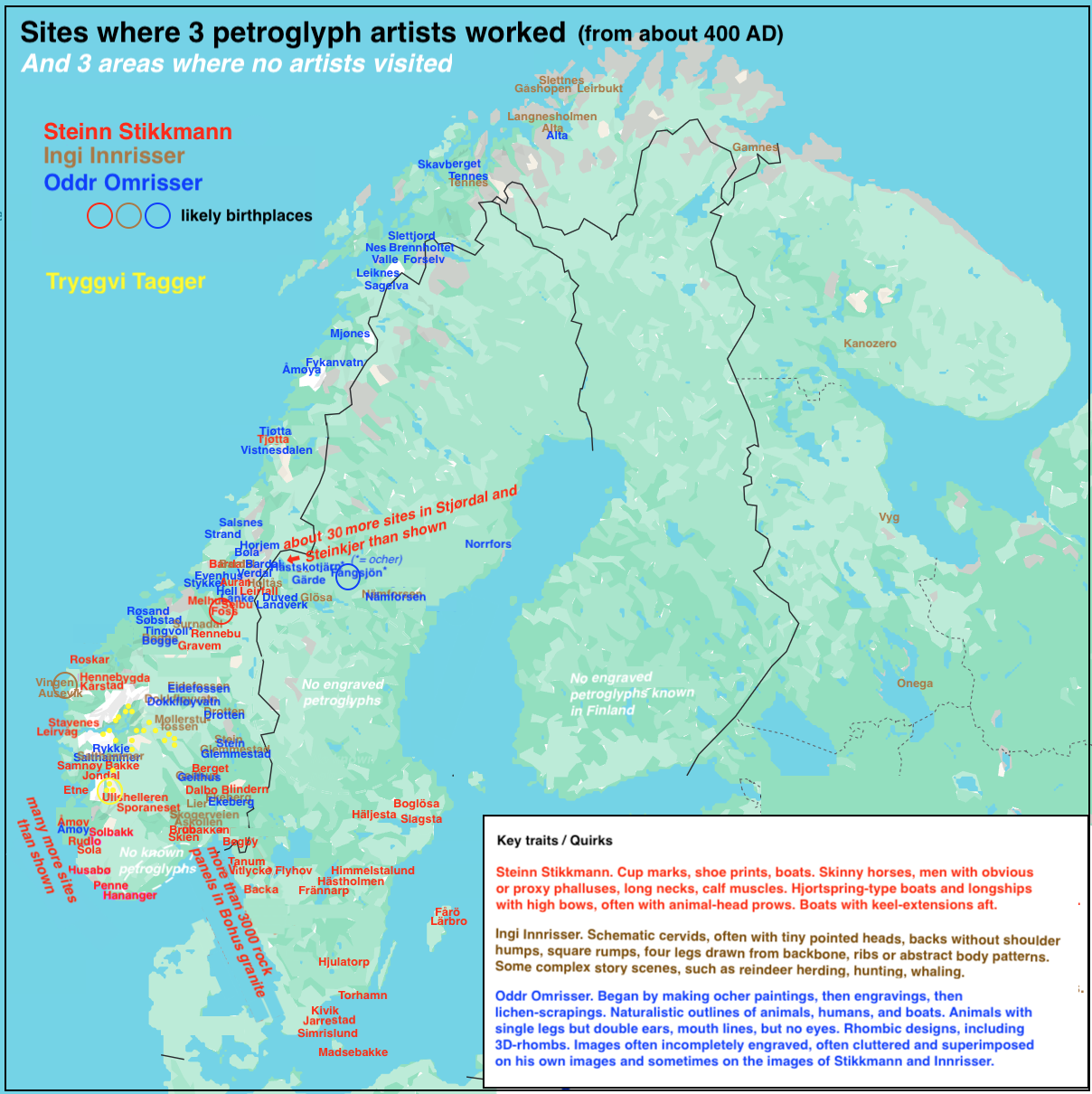
It is possible to consider the skills, motifs, and styles of the artists, and speculate about their artistic careers and travels. I explain my current interpretations here. In the blog posts at the bottom of this page, I link to the sources and explain my reasoning over the past three years. I write my interpretations as if they are certain, but they are all hypotheses that are subject to change.
Steinn Stikkmann discovered how to use a nail as a 'stabbing tool' (stikkvpen) to engrave relatively soft rocks in Gauldalen, central Norway. He also tried engraving with a knife point. Archaeologists have noted that the petroglyphs in Gauldalen are relatively crude. Stikkmann practiced engraving by making round 'cup marks' and sets of matching shoe prints that never show a pattern of walking. His favorite motif was boats. He drew many longships with two extensions fore and two extensions aft, like the Iron Age boat that was buried at Hjortspring, Denmark in about 350 BCE. But most of Stikkmann's longships were more seaworthy, with high bows and sterns. He drew a few thousand of them. The boats are asymmetrical with long keel-extensions fore, and short keel-extensions aft. They are said to be Bronze Age boats, but I think they are from about 400 CE. Curiously, Stikkmann showed the complete hulls of every boat, never indicating water or the water line.
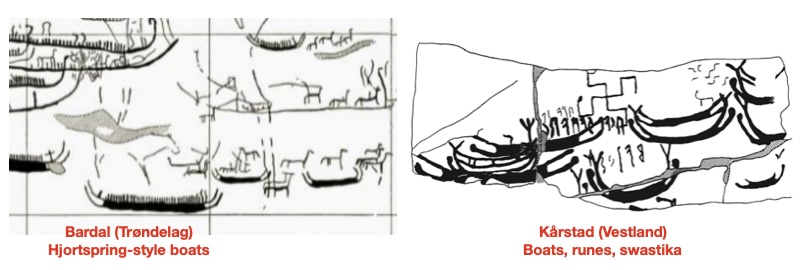
Stikkmann's art is highly stylized and easy to recognize. He drew extremely skinny horses, men with exaggerated calf muscles, long necks, and often with phalluses Ñsometimes an obvious phallus and scrotum, but usually disguised as a possible knife, sword, stick, or extraneous line. He used a ponytail hair style to indicate women. He exaggerated some things, such as extra-long longships with over a hundred crew members, and captains shown as giants standing in ships. Some of the captains have Viking-style helmets with horns. At a few places he showed an acrobat doing a backward somersault.
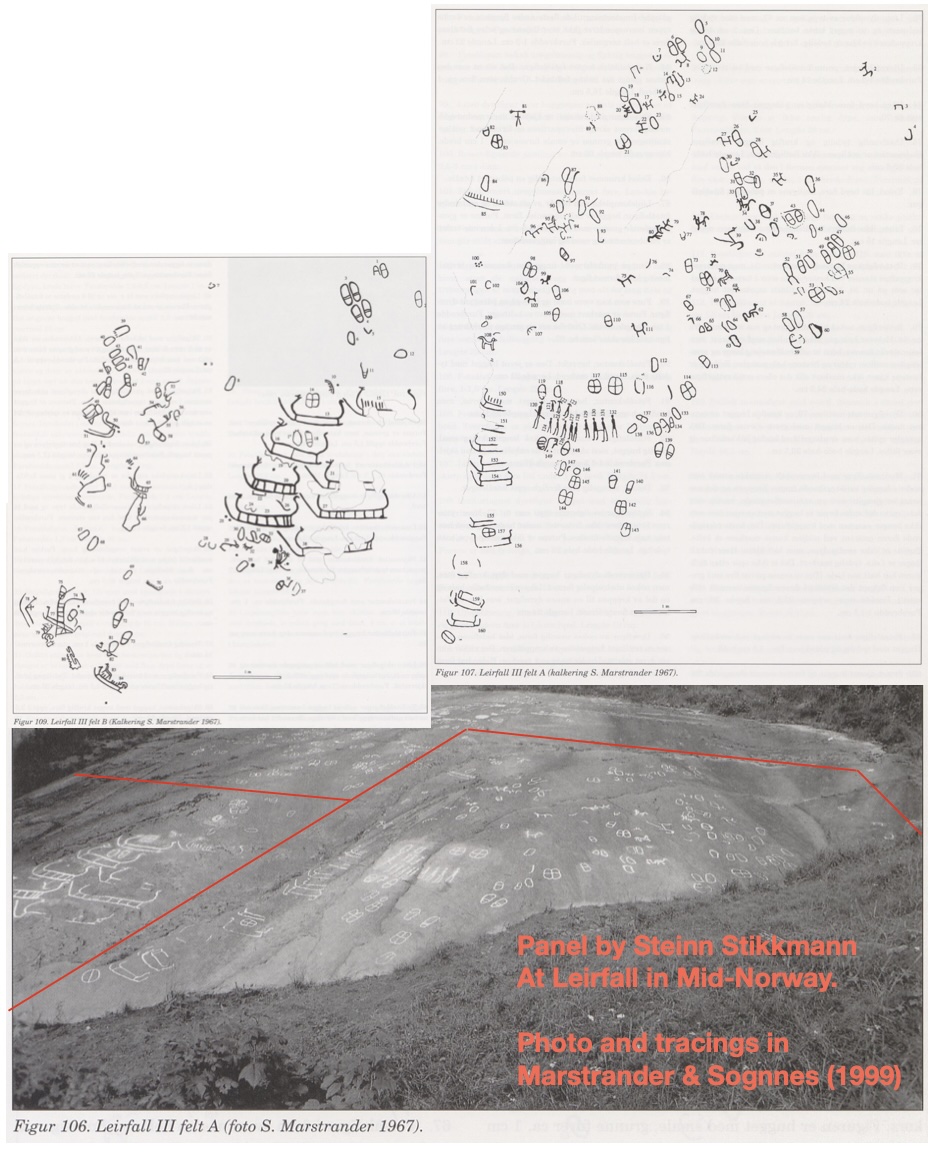
Stikkmann's petroglyph sites show where he traveled. I think he started at Foss (area 'A' on the map below), where he practiced engraving by making mostly cup marks on over 50 different panels. Foss was a wealthy settlement in 400 CE. Because of the waterfall ('foss') on the Gaula River, the chief of a travel station there could serve people traveling along this major river valley between central Norway and southern Norway. Archaeologists have found a chief's burial site at Foss containing artifacts of gold, and dated it to about 400 CE. A bog-iron smelting facility has also been found. Stikkmann may have been a chief's son, since he knew about runes. Stikkmann's real name may have been Foss: place names have been used as surnames since Viking times, and there are currently over 3000 Norwegians with the surname Foss.
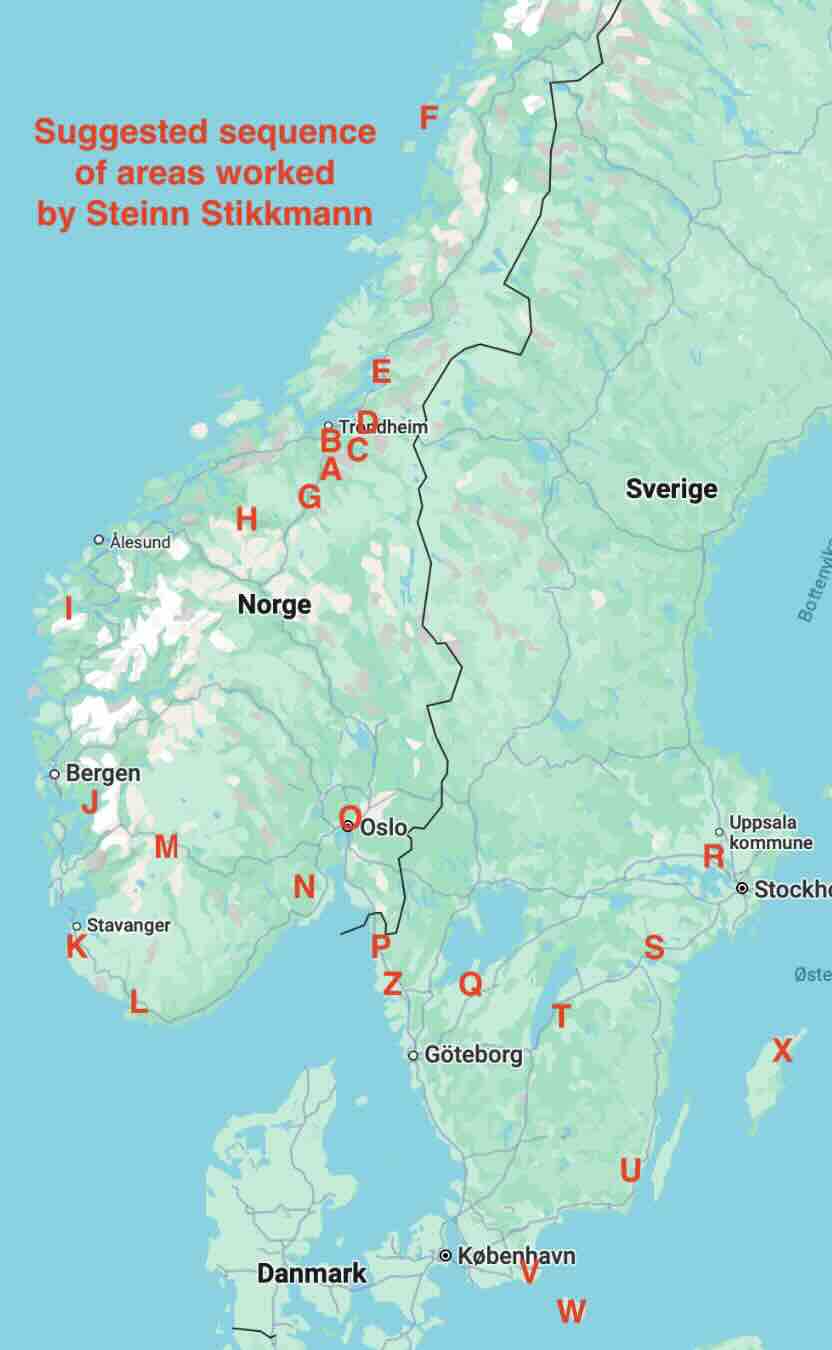
From Foss, Stikkmann went via Gauldalen (area B) to the lake Selbusj¿en (C) where he found boulders of granite that had been transported from Sweden during the Ice Ages. I think he was impressed with the qualities of granite, which is practically nonexistent in central Norway. He then went to Trondheims fjord, where he may have stayed for a few years. He made petroglyphs at many sites between Stj¿rdal (D) and Steinkjer (E). He took one long boat trip further north to Tj¿tta (F), which was an important settlement in the Iron Age.
Below is a typical Stikkmann panel at Tessem in the Steinkjer area (E). Note the shoe prints, two cup marks, skinny horses, and two phallic men with outstretched arms and exaggerated hands. There are two of his typical boats Ñone with 10 crewmen (or perhaps 20) and the other with 15 (or 30). Another panel nearby shows Elder Futhark runes.

Stikkmann undertook a great journey, maybe looking for panels (not just boulders) of granite. He may have begun at Foss (area A) in the spring. He walked to Rennebu (G) and Oppdal. He left few petroglyphs on this part of his trip, maybe because there was still snow on the ground. He avoided the high snowy mountains of Dovrefjell by walking west to Gravem (H) and out to the fjords. Then he traveled by longship around the coast (I,J,K) all the way to the southern tip of Norway (L). He did not continue further east along the coast, which helps explain why no petroglyph has ever been found in Aust-Agder. Instead, he made a U-turn and went back to Stavanger (K) and then traveled inland to Sporaneset (M) and Skien (N). From there he went wide around Oslofjord (N-O-P) and then came to the ¯stfold-Bohusln area (P).
Stikkmann spent most of his life in the ¯stfold-Bohusln area (P,Z), working with the Bohus Granite. He made petroglyphs on thousands of rock panels there. The Bohus Granite was ideal for his petroglyphs. The granite panels are hard and smooth, with no layering and relatively few fractures. (Gustav Vigeland used Bohus granite to carve the monolith and statues in Frognerparken.)
Stikkmann went beyond the Bohus Granite, to try rocks in other areas (Q-X). He visited eastern Sweden (R, S, T, U) and the southern tip of Sweden (V), and the islands Bornholm (W) and Gotland (X). He must have been famous, because he was invited to engrave rock slabs for the monumental 'King's Grave' of Kivik (V).
Stikkmann liked the motif of horses pulling a chariot, and showed this at Staveneset (I), Begby (P-Z), Bjrnerd (P-Z), Brastad (P-Z), Frnnarp (Q), and Kivik (V). He also liked to show processions (see the photos below.) He engraved his first procession at Leirfall (D) and maybe his last at Kivik (V) or Tanum (P,Z).
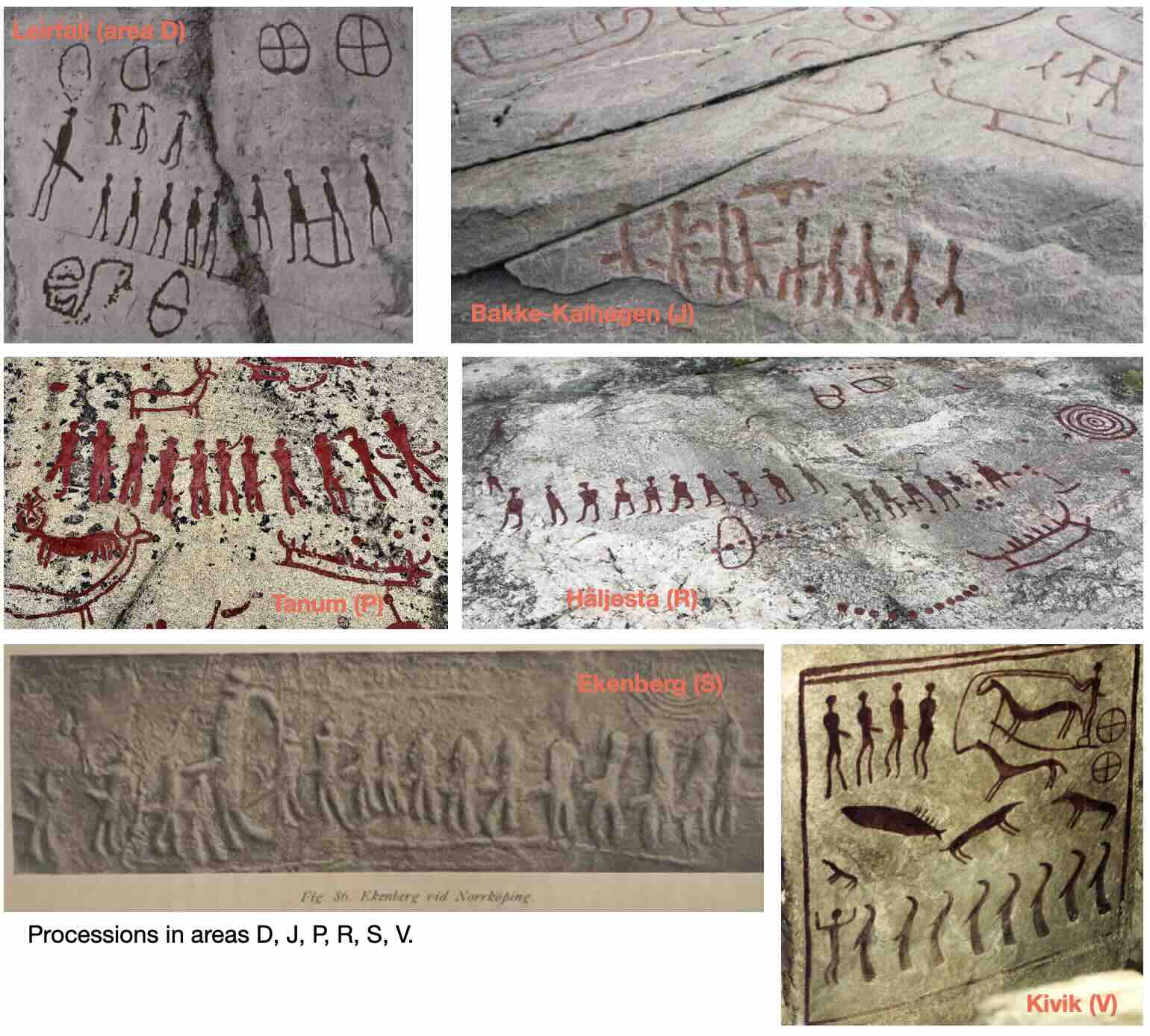
I suppose that Stikkmann owned no house or property, and that people gave him room and board wherever he went. Being well traveled and educated he was probably a popular house guest. He repeated his favorite motifs at site after site. He especially enjoyed making ships, cup marks, shoe soles, phallic men, and skinny horses. He made so many ships, that we might say "Same ship, different day." If there had been many artists in these areas, I think there would be other motifs, such as fishing boats, hunting scenes, activities involving women and children, domestic items such as tents or houses, tables, chairs, people eating and drinking, etc.
Ingi Innrisser had a childlike or primitive artistic style. He drew mostly cervids Ñdeer, reindeer, moose, or elk. They often have small pointed heads. A few at Vingen may be horses, since they seem to have riders. He liked to decorate the bodies of animals and humans with ribs or various patterns, including geometric designs.
Innrisser sometimes told stories. At Alta he showed corrals with domesticated reindeer. In one corral scene (see the tracing below), a bear had wandered from its winter cave and into a reindeer corral. In other story scenes, Innrisser showed men with bows and arrows hunting bears, and in Russia he showed a man hunting bears and cervids in the snow, making ski tracks part of the way (downhill?), and foot tracks part of the way (uphill?). At Alta he showed several different men making snowshoe tracks, but there was no indication of skis. Near the White Sea in Russia he showed many scenes with boats (with animal-head prows) harpooning beluga whales.
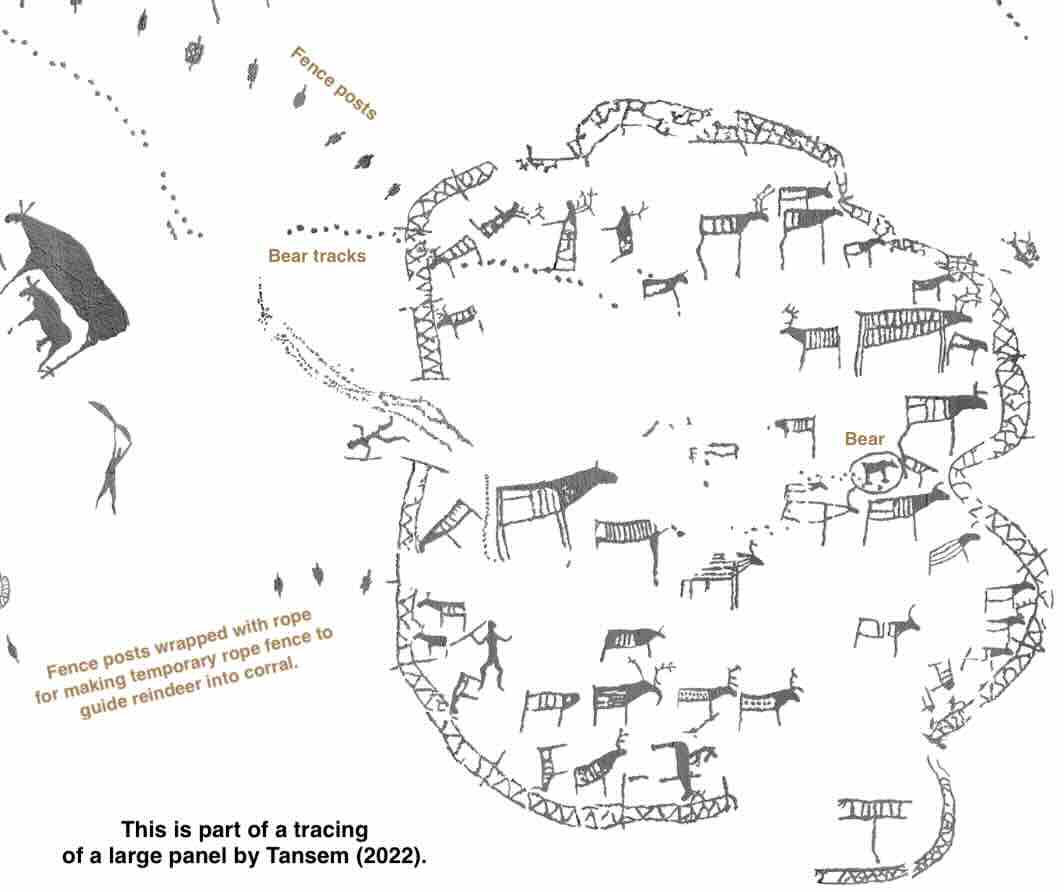
From analysis of Innrisser's motifs and styles, I am trying to follow his career. I think that his first work was at Vingen, where there are about two thousand engravings. I think he made them all. They include his new-beginner attempts on loose rocks that he could hold on his lap while engraving. The plate below, from Johannes B¿e (1932), shows some of these loose practice rocks. The scale bar for each rock is 20cm. Note the curious hook figures.

Innrisser engraved hundreds of hook figures at Vingen. They comprise about 20% of his images there and are not really understood. He may have engraved the hook figures simply to practice engraving. He made many at Alta, such as in the figure below, and there we can see that they are animal-head sticks. Many of them are being held up by men in poses of power. He also made a few such sticks at Nmforsen and in Russia. Maybe Innrisser was inspired by an animal-head walking stick that his father or grandfather had owned.
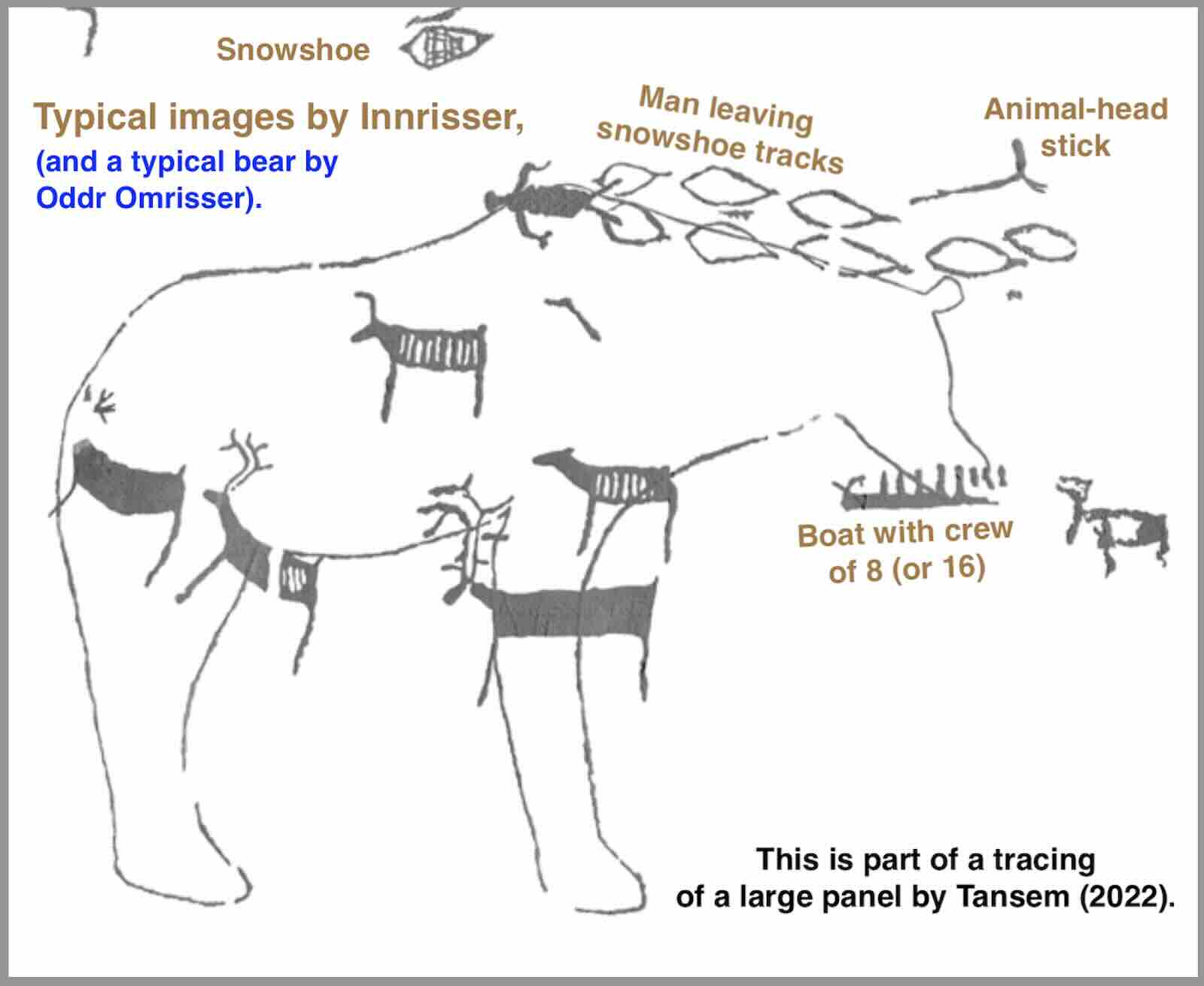
Vingen is an isolated place, and I think there has never been a settlement there. I suspect that Innrisser actually lived in the populated Skatestraumen area, about ten kilometers by row boat from Vingen. (Tidal currents make the boat trip easy at certain times each day.) He probably learned about Stikkmann's nailpoint engravings from seeing them other places nearby.
After engraving petroglyphs at Vingen, Innrisser probably took his first long trip to Tennes and Alta. I think he showed Oddr Omrisser how to engrave rocks on that trip. Both his engravings and Omrisser's at Tennes are quite crude. His next major work was probably at Ausevik. His human figures at Vingen, Alta (Storsteinen/Amtmannsnes), and Ausevik are all wildly abstract. So were many of his cervids. He was experimenting with creative ways of drawing. The compilation below by L¿d¿en (2012) shows 27 of the 61 humans that Innrisser engraved at Vingen.

The tracing below shows one abstract human and about 10 cervids at Ausevik, all drawn by Innrisser in his experimental phase. No two figures look alike.

At most of Innrisser's sites (but not Vingen or Ausevik) he was together with Oddr Omrisser. Omrisser encouraged Innrisser to make his cervids more anatomically correct Ñwith shoulder humps, muscular legs, and larger heads. At Holts I in Tr¿ndelag (see the tracing below left), I think Innrisser mocked Omrisser by making silly looking shoulder humps above the straight backs of his cervids. Innrisser and Omrisser took a long trip to eastern Norway (Oslo and Drammen), following one river valley south, and another back north. Innrisser added shoulder humps at those sites as well, such as at Skogerveien (see the tracing below right).


Recognition of Innrisser's motifs sheds new light on petroglyph oddities. In the tracing above right (Mikkelsen 1977), the strange objects at Skogerveien (Drammen) are probably snowshoes or snowshoe tracks, something Innrisser drew many places at Alta, and in Russia. In the tracing below, a man standing in the animal-head boat is probably holding up a pair of snowshoes. The objects below that man may be an animal-head stick, and a bundle of reindeer hides to be taken by longship to southern Norway. I have colored two animals in blue, because they were added by Omrisser, and not really part of Innrisser's panel.
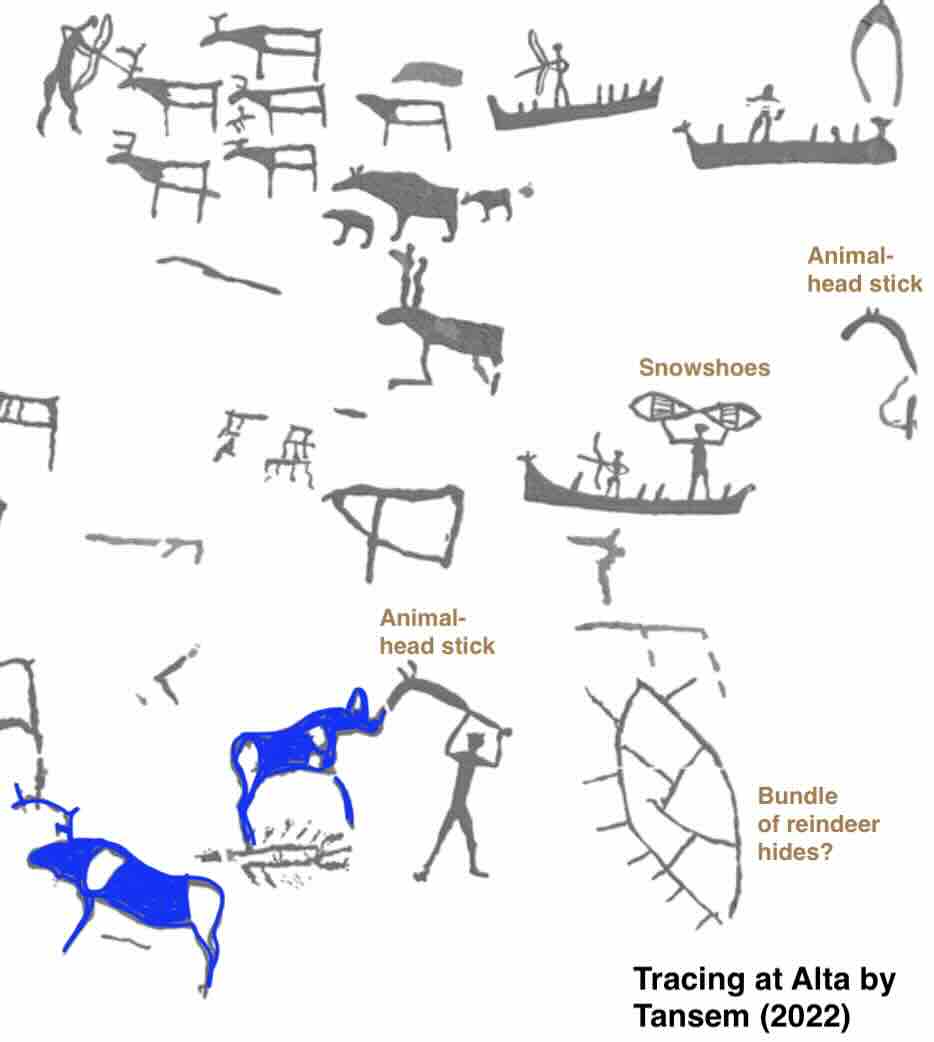
I suppose Innrisser went by longship via Alta to the White Sea, and as far south as Lake Onega. I have not determined when in his career he went to the Russian sites, or if another artist was involved. He showed some of his usual motifs in Russia, but he drew humans in profile, which he had not done before. He drew a man making long ski tracks. In Norway he did not show skiers. (I think there are no petroglyphs in Norway that document skiing. The images of 'Stone Age skiers' at Tj¿tta and B¿la are by Omrisser, and actually show men standing in partially drawn boats. A supposed 'skier' at Alta is actually a man on snowshoes.)
Oddr Omrisser usually made outlines of his objects Ñof animals, of boats, of people, and even of the antlers of reindeer and the penises of men. He made images large and even life size when possible. He was a naturalist, and many of his animals are amazingly well drawn. The species of his cervids, birds, fish, and whales can often be identified. He had his quirks. He liked to draw a line for the mouth, but no eye. He often ignored the feet, leaving the legs unfinished or ending as points. He usually drew animals in profile, but often gave them two ears that form a V. He showed only one foreleg and one hind leg on four-legged animals. (Innrisser usually drew all four legs.) He sometimes indicated internal organs of animals. He rarely showed interactions among figures. However, at two sites (Bardal in central Norway, and Alta in northern Norway) he showed a large naturalistic man with an erection approaching a diminutive woman from behind. He showed another phallic man at Lnke near Stj¿rdal.
Omrisser's engravings are typically overlapping and incomplete. He had the curious habit of defacing rock panels by carving large and inappropriate images right on top of others. He cluttered most of his own panels in that way, and Stikkmann's panels at Bardal I and Stavanger, and Innrisser's panels at Alta, Bogge I, and Holts I.
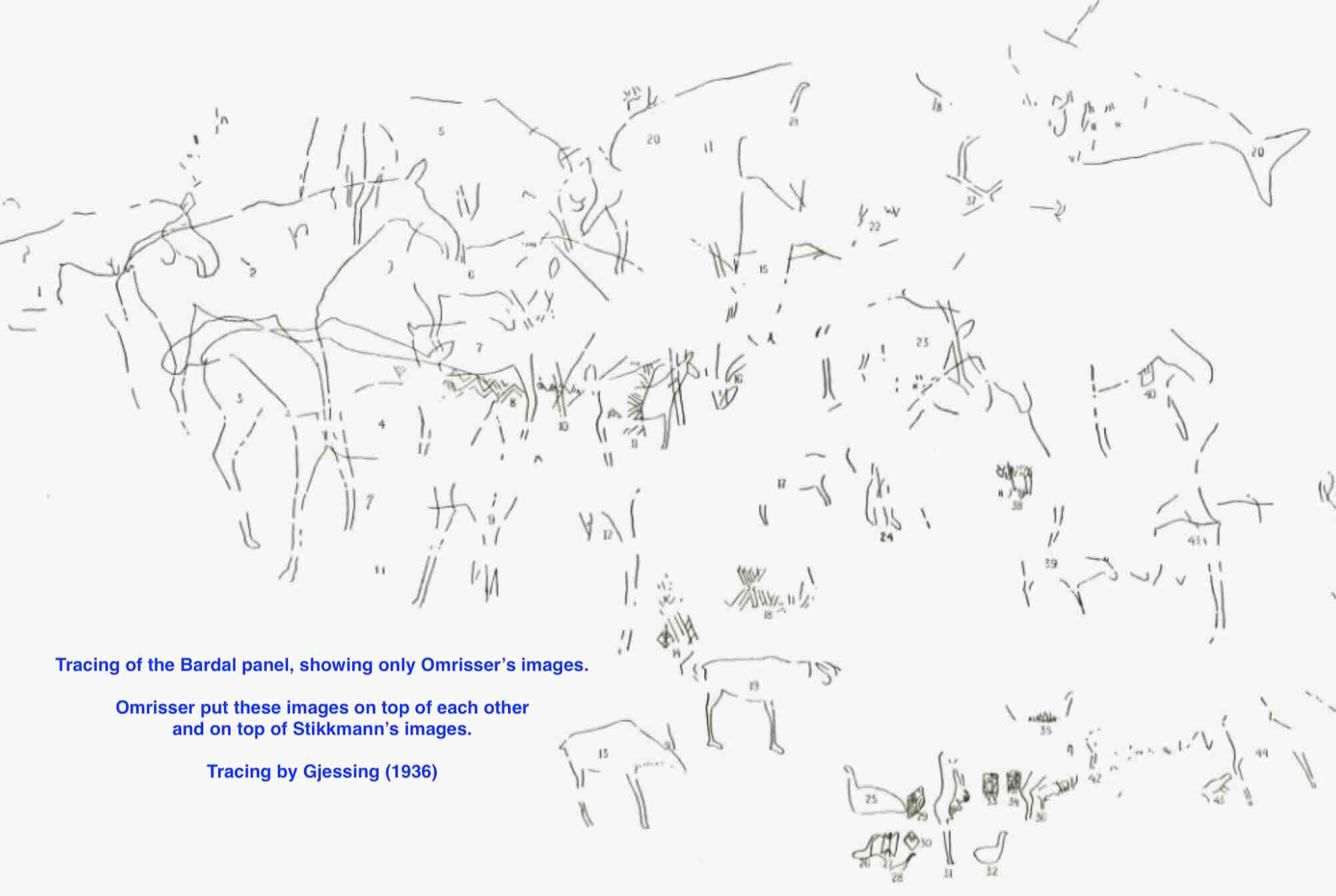
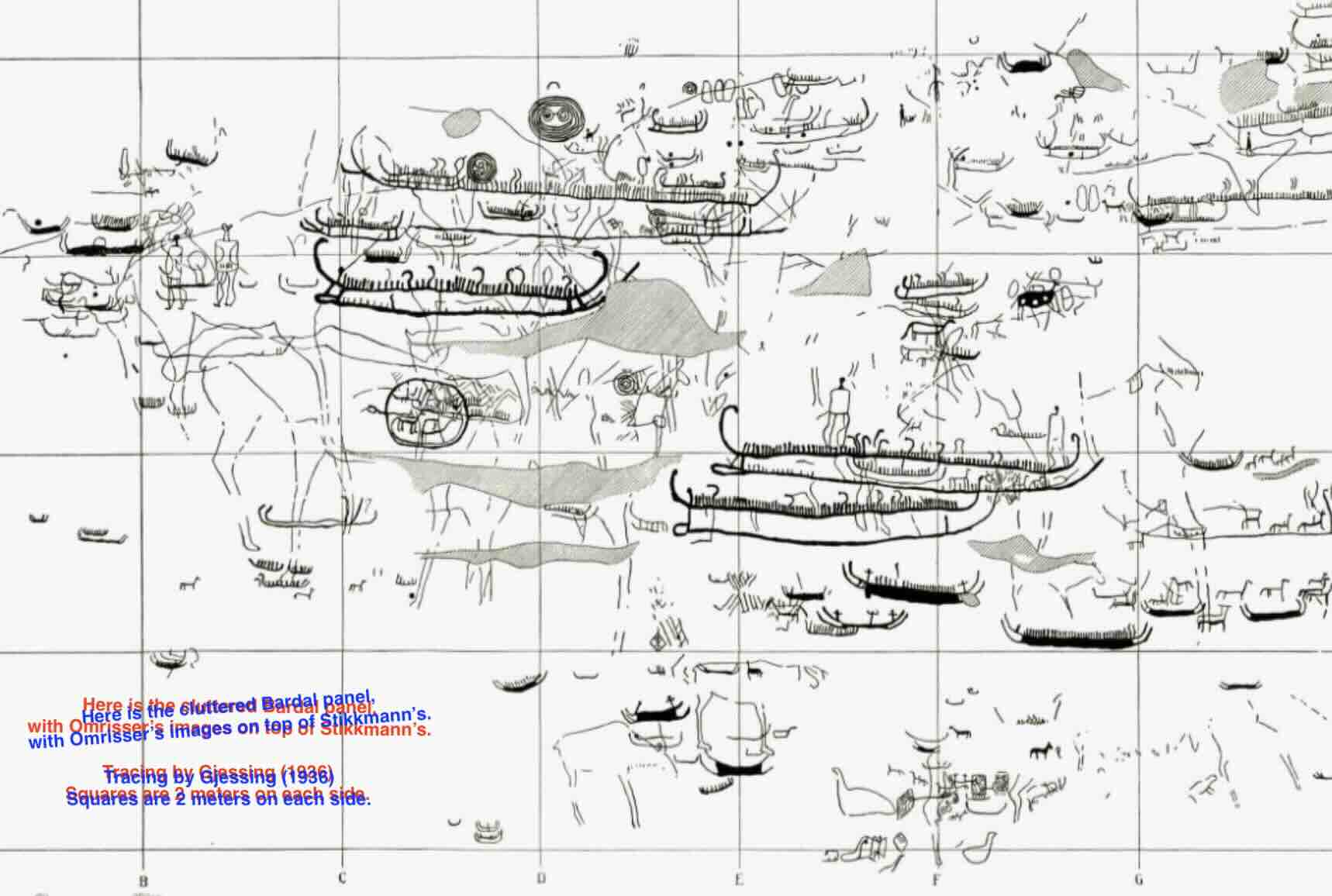
At Bogge I, Innrisser carved many cervids, and then Omrisser put a moose on top of some. He engraved a deer's head there as well. Below is part of the tracing by Gjessing (1936) of the defaced panel, where I have colored Omrisser's two images blue. I think Innrisser told Omrisser to get away and find another place to work. So Omrisser went down the hill and made two panels of his own (Bogge II, Bogge III). The same thing happened at Holts I and Holts II.

Below on the left is a tracing by Fett & Fett (1941) of a panel of typical boats and shoe prints by Stikkmann at Stavanger (m¿ya). Omrisser put several outline images (which I have changed to blue) on top of Stikkmann's images. On the right is a tracing by Tansem (2022) of a panel by Innrisser at Alta (Kfjord), where Omrisser put his outline images on top of Innrisser's images. Note that Omrisser drew the same fish at Stavanger and Alta, and the same incomplete deer's head at Bogge I and Alta. He made that same distinctive deer's head (often without the body of the deer) many places in Norway and Sweden.
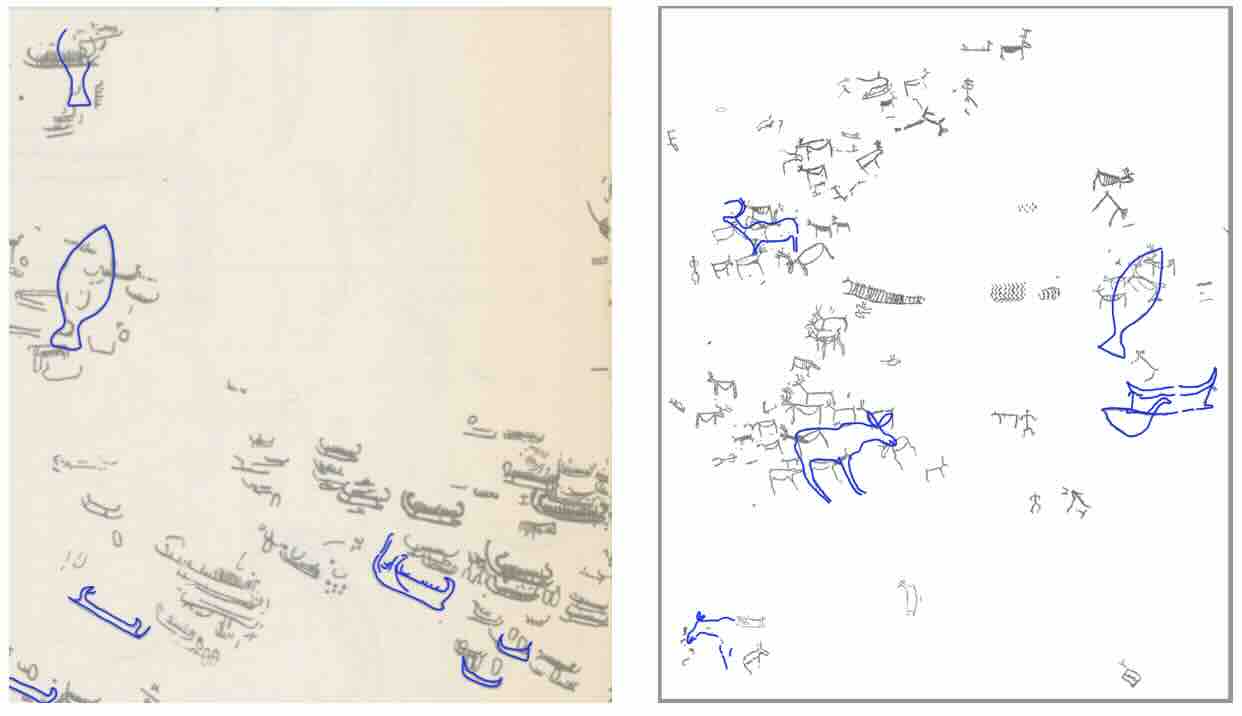
Some of Omrisser's added images almost fit in. At Bergbukten (Alta), Omrisser added reindeer to a panel of reindeer and a corral by Innrisser. All the images are painted red by Alta Museum, but I have changed Omrisser's images to blue in the photo.

(Allan Krill photo 2022.)
Early in his career, Omrisser painted rock panels at dozens of sites in northern Sweden, and a few sites in central Norway, and maybe a few in Alta. He used red ocher pigment, probably mixed with fat that penetrates the rock surface, leaving red traces that are still visible after more than a thousand years. He must have worked during the winter or spring in Sweden, when he could stand on ice-covered lakes and paint rock panels at the lake edge. Later, he also made engravings while standing on frozen lakes. I suspect that he was born south of Strmsund Sweden, where there is a cluster of his rock paintings, all within skiing distance from each other. That is not far from Nmforsen, where he and Innrisser made nailpoint petroglyphs.
Omrisser's earliest engravings may have been the crude ones at Tennes and Storsteinen (Alta). We see this most clearly in his porpoises, a motif that he liked to draw (always with the tail pointing down.)
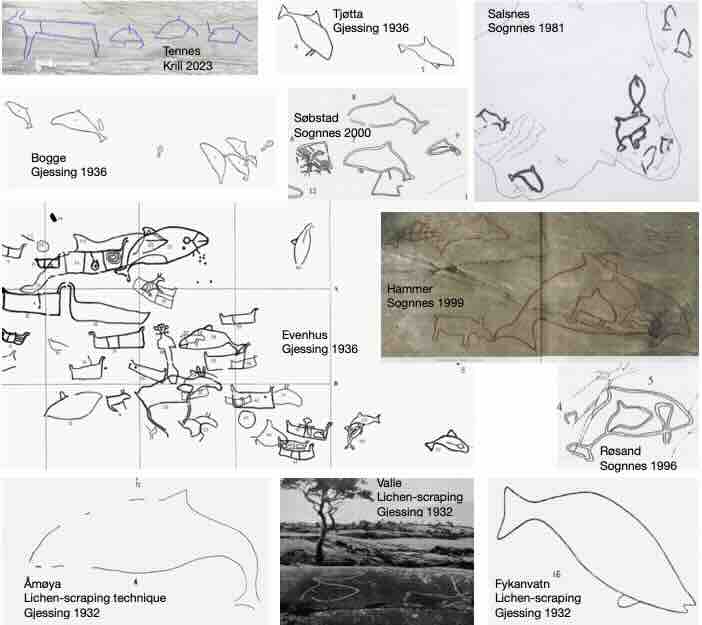
Omrisser used four different petroglyph techniques during his career. He started with red ocher stain, but mostly he used the nailpoint technique. On two panels of soft rocks (at Grde and Hell) he used a knife point. Late in his career, at the peak of his anatomical knowledge and drawing skill, he discovered that he could quickly and easily make large petroglyphs by scraping away black lichen that covers the surfaces of hard white granites. He made life-sized images of animals (and a 4.3 meter long boat) using that technique at seven coastal sites in Nordland ÑLeiknes, Fykanvatn, Mj¿nes, Nes, Sagelva, Valle, and m¿ya.
Omrisser made Scandinavia's largest images. His outlined orca whale at Leiknes (below left) is 7.5 meters long, and his outlined boat near Stavanger on one of Stikkmann's panels (below right) is 5.5 meters long.
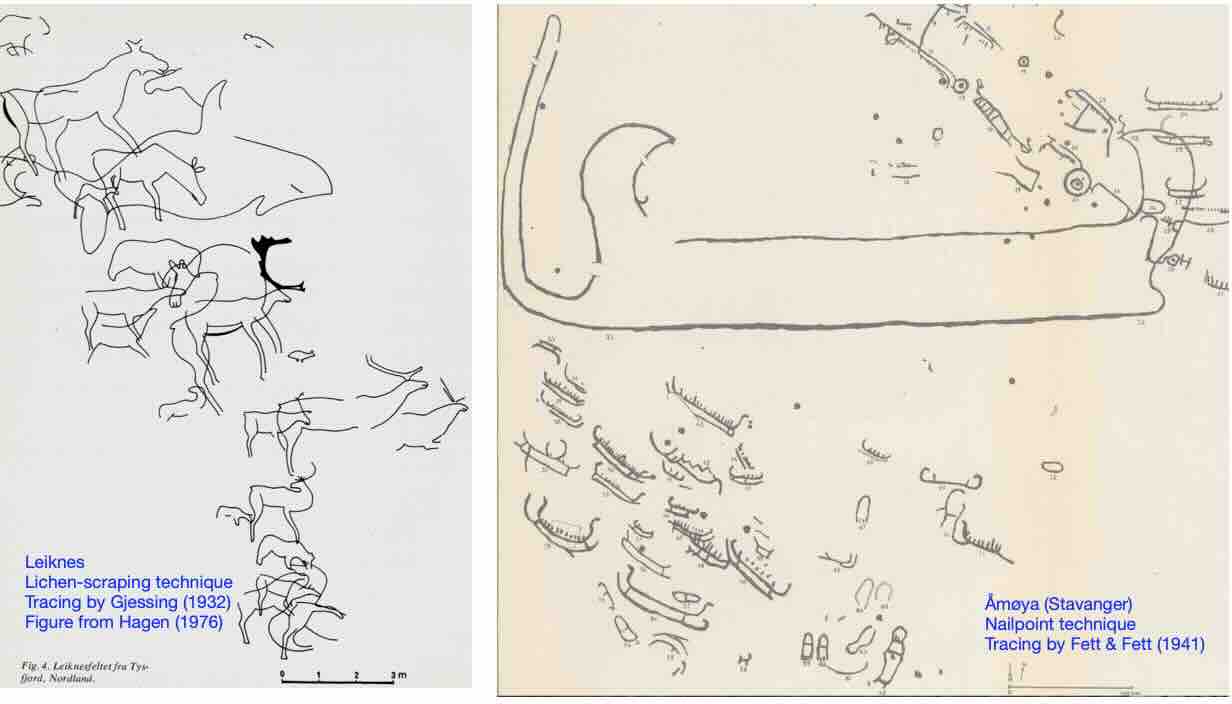
Omrisser 'signed' many of his panels with rhombic designs. The ones at Fngsjn (Jmtland), Hell (Tr¿ndelag), and Forselv (Nordland) have a unique 3D-look.

Tryggvi Tagger. In our 'Urban Age' we are familiar with graffiti and tagging. Petroglyphs were graffiti art, and Stikkmann, Innrisser, and Omrisser were Iron Age 'Banksys'. A fourth person, whom I call Tryggvi Tagger, made cup marks on boulders in high mountain areas of southern Norway. The photo below of Tagger's cup marks was published by Johannes B¿e (1932) and reproduced as Fig. 156 in The Rock Art of Norway by L¿d¿en & Mandt (2010).

Tagger's engravings were not artistic, but simply marked his presence. I think he learned the nailpoint technique and the joy of making cup marks from seeing Stikkmann's engravings in Ullensvang on the east side of Hardangerfjord. Tagger made hundreds of cup marks on about 50 boulders near Stikkmann'a sites. From there he went north and northeast, tagging cup marks on over a hundred boulders over a huge area, as far away as 150 km from Ullensvang.
Tagger and Stikkmann made lots of cup marks, but Innrisser and Omrisser never made any.
Runestones were engraved by other artists who also probably used the nailpoint technique. There are about 10 runestones with Elder Futhark runes (24 character alphabet) in Norway and Sweden. I know of none that include images. There are over 2000 runestones with Viking-Age Futhark runes (16 character alphabet) from 800-1030 CE. Many of these runestones have interlocking images, and none resemble the images of Stikkmann, Innrisser, or Omrisser.
Petroglyphs cannot be dated directly, and that has been a problem in archaeology. People expect archaeologists to tell how old a petroglyph is, and everyone values an artifact more if it is very old. Norwegian archaeologists adopted the 'shoreline dating' method a century ago, which maximizes the age and value of an artifact. Shoreline dating gives the time that the land area rose above the sea during post-glacial uplift. That is the oldest possible time of human activity on that land Ñbut not the most likely time.
At many petroglyph sites, images high on a rock panel are said to be hundreds of years older than similar images a few meters lower down. At Alta, the age difference is said to be over 5000 years. The figure below from Gjerde (2024) shows the supposed phases of rock art at Alta. I have added the ages for those phases in red. For various reasons, I can assign most of the images to either Innrisser (brown) or Omrisser (blue). Note Innrisser's experimental abstract humans at Storsteinen (Phase 3). He also made abstract humans at Amtmannsnes (which would be Phases 1 and 2) and at Vingen and Ausevik. The four phases of images at Alta are not valid, and the ages apply only to the shore levels, not the images. No petroglyphs were made on the slippery rocks at the Stone Age shorelines.
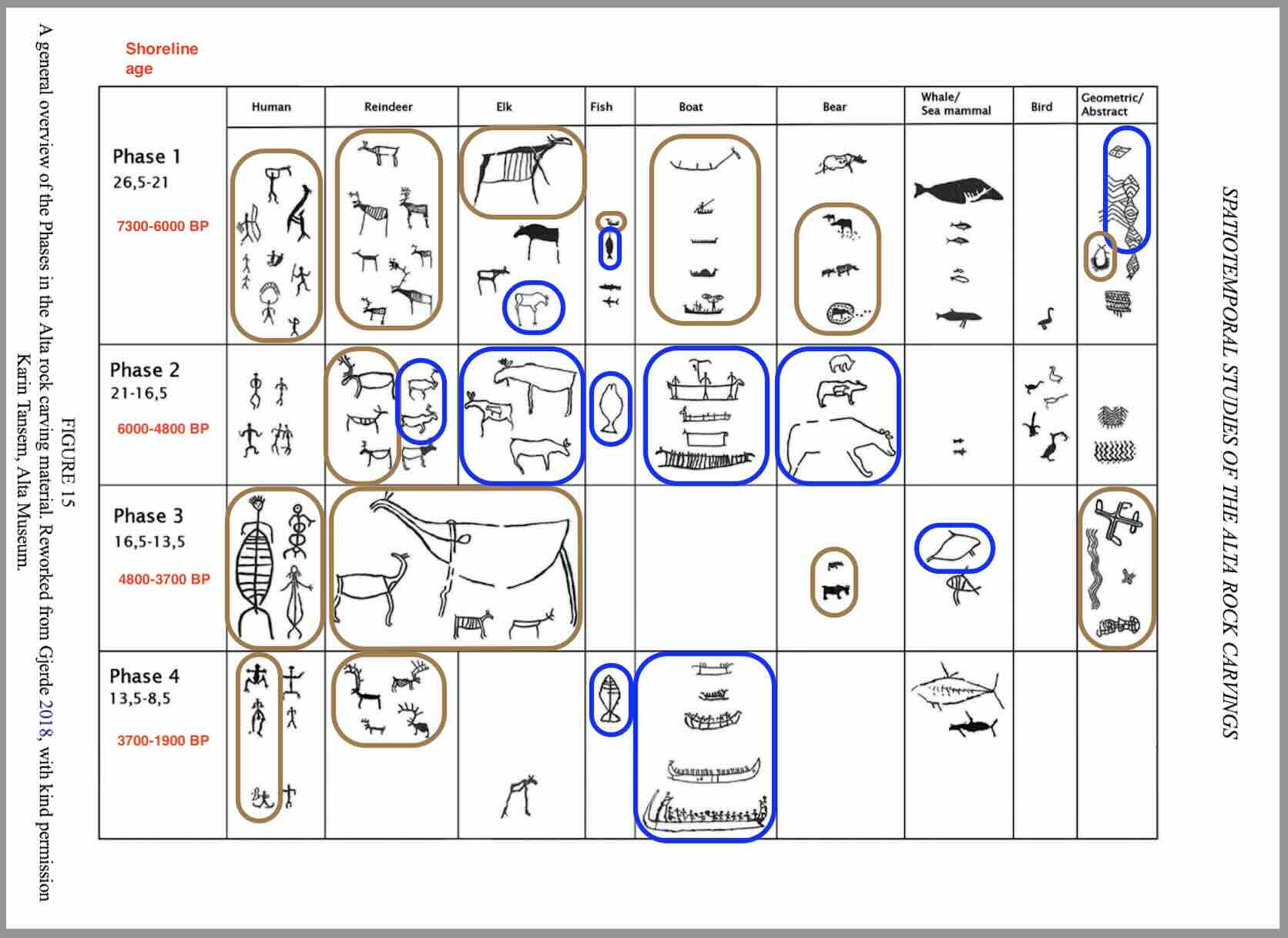
I think that that positions of engravings on a rock panel have no chronological significance, other than within a single day's work. Petroglyph artists probably tended to move upward on a hillside as they worked, as geologists often do. Look again at the tracing at Leiknes with the 7.5-meter orca whale. I suppose that Omrisser produced those lichen-scraped images in a single day, working from the lowest image to the highest. In contrast, Gjerde (2010) suggested that the lower images were drawn a few hundred years after the upper images, about 8,000 years ago.
Shoreline dating, and the belief that people inhabited the Norwegian coast while Ice Age glaciers were melting 10,000 years ago, was established by Anders Nummedal. He was a school teacher with an education in geology. I contend that from 1909 to 1939 he made stone implements himself, and then said he found them on uplifted beach terraces. Many of his artifacts were chipped from rounded beach cobbles of poor quality stone. There are no rust stains or lichens on the chipped surfaces. That tells me that they were freshly made, not 'found'. Nummedal's goal was to create a belief in Stone Age inhabitants (his Komsa and Fosna Cultures), and to create an archaeology career for himself. I am certain that he falsified finds on uplifted Stone Age beaches at over 200 sites in central Norway and over 60 sites in Finnmark. He wrote that he easily found artifacts, and that it was his fate to discover Norway's prehistoric settlements.
Archaeologists were fooled by Nummedal's deceit for many years. Then they stopped including references to his pioneering publications in their own works, and stopped encouraging students to read his reports. Scrutiny of his claims would jeopardize their own careers in Norwegian Stone Age archaeology. I have translated his book Le Finnmarkien: Les origines de la civilisation dans l'extrme-nord de l'Europe and delved into archaeological hoaxes see Hoaxyz.com. My goal is to alert new archaeology students to the existence of falsifications and errors. I hypothesize that there was no flint in Norway in the Stone Age, and no permanent inhabitants. (Flint could not be transported to Norway by ice, as archaeologists claim. It came by longship. A typical longship from Denmark would have hundreds of kilos of flint boulders as ballast, which would be dumped on the first Norwegian beach it visited.)
The two maps below show all the areas with petroglyphs in Scandinavia. If there were cultures that made the petroglyphs, as archaeologists have maintained, I think petroglyphs would not be absent in areas that would naturally have been populated. The map patterns suggest that only a few artists worked at places during their travels. I contend that Stikkmann made all the supposed 'Bronze Age' petroglyphs, except for a few made by Omrisser at Nmforsen, Stavanger, and Alta. Innrisser and Omrisser made all the supposed 'Stone Age' petroglyphs, except for at Sporaneset, which were made by Stikkmann. They were all made in the Iron Age, between 400 CE and 800 CE. Scandinavian geography must have been well known by early Vikings with longships, long before their boats had sails.
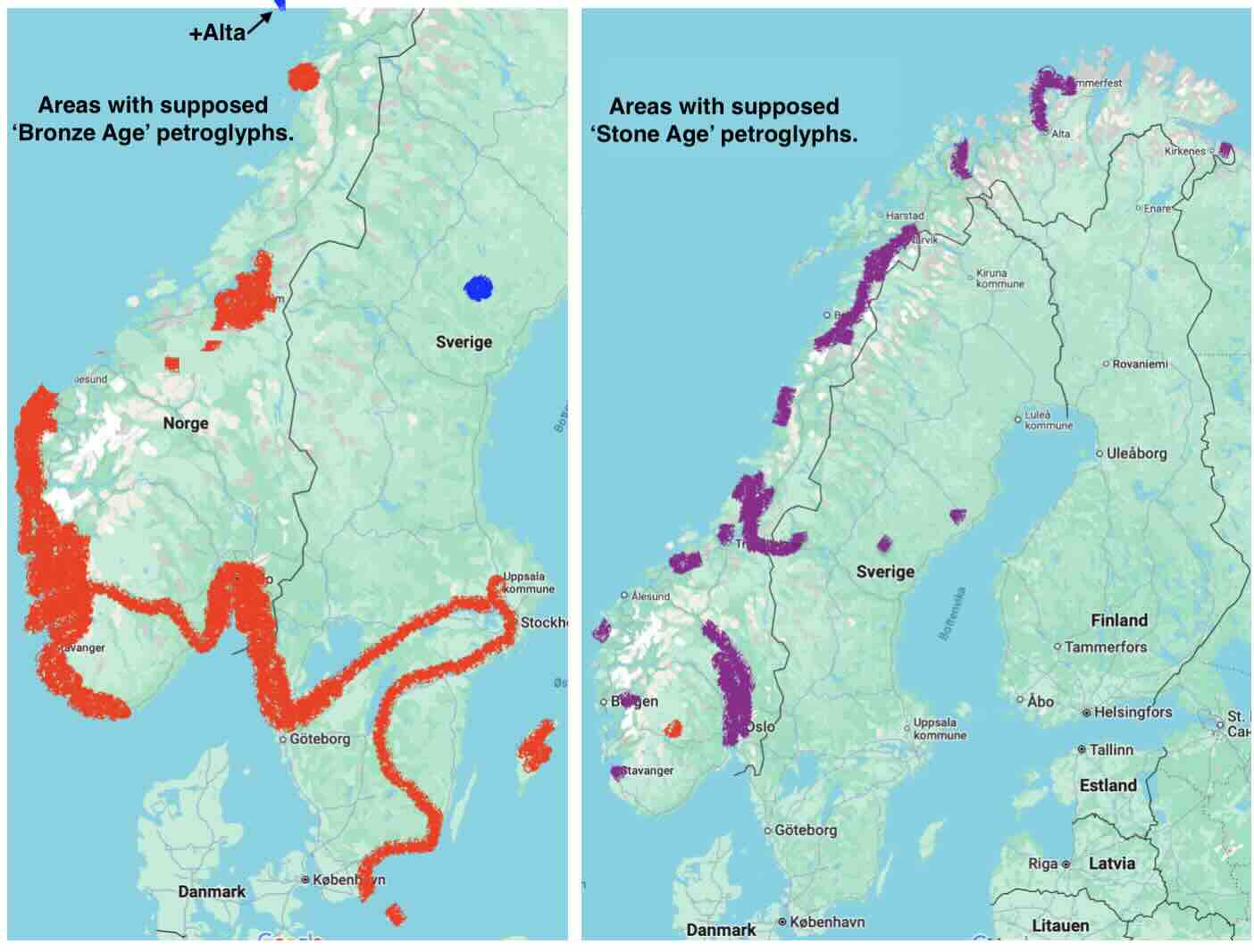
Some rock panels with 'Bronze Age' petroglyphs were partially below sea level during the Bronze Age. Images on a panel discovered in 2023 at Edsten (see the pictures below) could have been made only at the end of the Bronze Age (500 BCE) or in the Iron Age. It is said that the artists were in boats while engraving such low-elevation panels. I cannot believe that an artist would or could stand in an unstable boat to engrave the hard Bohus Granite at the shoreline. It was easier in 400 CE, when the panels and meadows were well above sea level. In any case, if engravings were pecked with stone or bronze tools, broken tool fragments would have fallen to the ground, and might be found.


Archaeologists are committed to their paradigm that petroglyphs document enigmatic cultures of the Stone Age and Bronze Age. Professionals have expertise that is suited to an established paradigm, and most of them will not shift or even discuss an alternative paradigm. I know this from research for my book Not Getting the Drift about the paradigm shift from fixed continents to plate tectonics in geology. It's like American football players who now know about CTE brain disease, but their expertise is in football, and they can't shift to basketball or some other sport. Another example is Jesuit priests, who are known to be good scientific researchers, but if they discussed whether Jesus really walked on water, they would lose their funding.
No one likes an outsider telling them that they are wrong. Archaeologists have not answered my emails or come to my lectures, and journal editors have refused to send my manuscripts to peer review. But as a professor, I want to document my research, and warn students to be wary of Scandinavian Stone Age archaeology. If you would like to discuss this new paradigm, you may share your hypotheses and evidence here: https://groups.io/g/VikingRockArt
Allan Krill
allankrill@gmail.com
PS: Differing mindsets in geology and archaeology. I map petroglyph artists in the way that geologists map rocks. A geologic mapper studies a rockÕs minerals and textures at a key site and invents a name for that rock. (For example the 'Jergul Gneiss', a name I invented in 1985.) Rocks vary from place to place. If the rock at another site seems about the same, a mapper uses the same color on the map, and the same rock name. If the rock seems too different, another color and name are used. Geologists who prefer few names are known as lumpers, whereas those who prefer many names are splitters. I am a lumper ÑI currently think there are only three petroglyph artists.
Below is a geologic map of Fennoscandia (Norden) from 1933. The rocks vary in age and appearance, and have been given local names. Note the Bohus Granite ÑStikkmann's favorite rock.

Geologists and archaeologists interpret past events. One of the guidelines in geology is: ÒThe present is the key to the past.Ó Another might be: ÒAn explanation should eliminate questions and require no further discussion.Ó Guidelines in archaeology seem to be: ÒPresent oddities may have been normalities in the past.Ó And: ÒAn explanation should popularize questions and encourage wide discussion.Ó Archaeologists make oddities such as cup marks, shoe prints, hook figures, phalluses, and fluky site locations interesting, not mundane. For archaeologists, petroglyph images show the existence of exotic cultures that performed rituals at significant places. For me, petroglyph images show visits by artists with normal interests and forms of expression. I look forward to hearing additional views.
Click on a site name to see some of the petroglyph images.
300 sites. Helleristning/helleristninger, helleristningar, hllristning/hllristningar.
Almfjellet, Tr¿ndelag (Omrisser) [ocher technique]
Alta, Finnmark (Innrisser + Omrisser)
Alta Bergbukten 1, Finnmark (Innrisser shown in red)Ê(Omrisser shown in blue)
Alta Kfjord, Finnmark (Innrisser shown in black)Ê(Omrisser shown in blue)
Alta Amtmannsnes, Finnmark (Innrisser)
Alta Apanes, Finnmark (Omrisser)
Arnstad, Tr¿ndelag (Stikkmann)
Askum, Bohusln +page (Stikkmann) [runes]
Askvoll, Vestland (Stikkmann)
Aspeberget, Bohusln (Stikkmann)
Aubeberget, Rogaland +page (Stikkmann)
Auran, Tr¿ndelag (Stikkmann)
Ausevik, Vestland (Innrisser)
Backa, Bohusln +page (Stikkmann)
Bakke, Tr¿ndelagÊÊ(Stikkmann)
Bakke-Kalhagen, Vestland (Stikkmann)
Balken, Bohusln (Stikkmann)
Bardal I, Tr¿ndelag (Stikkmann + Omrisser)
Bardal I, Tr¿ndelag (Omrisser, with Stikkmann's work not shown)
Bardal II, Tr¿ndelag (Stikkmann + Omrisser) [39% cup marks, 21% shoe soles]
Bardal III, Tr¿ndelag (Innrisser)
Bavneh¿j, BornholmÊ(Stikkmann) [99% cup marks]
Begby, ¯stfold (Stikkmann)
Berga, Vstmanland (Stikkmann)
Berget, Buskerud (Stikkmann)
Bingsfossen, Akershus +page (Stikkmann)
Bjrksta, Vstmanland (Stikkmann)Ê
Bj¿rngrd, Tr¿ndelag (Stikkmann)Ê
Bj¿rset, M¿re og Romsdal (Omrisser?)
Blindern, Oslo (Stikkmann)Ê
Blholt, BornholmÊ(Stikkmann) [44% cup marks]
Bogge/Boggestranda I, II, III, M¿re og Romsdal (Innrisser + Omrisser)
Bogge I, M¿re og Romsdal (InnrisserÊ+ Omrisser)
Bogge II, M¿re og Romsdal (Omrisser)
Bogge III, M¿re og Romsdal (Omrisser)
Boglsa, Uppland (Stikkmann)
Boglsaby, Uppland (Stikkmann)
Bokens, Bohusln (Stikkmann) [95% cup marks]
Borgenveien, ¯stfold (Stikkmann)
Bornholm, Denmark (Stikkmann)
Brandskog, UpplandÊ(Stikkmann)
Brastad, Bohusln Ê+pageÊ(Stikkmann) [36% cup marks]
Bremset, Tr¿ndelag (Stikkmann)
Brennholtet, Nordland (Omrisser)
Brillinge, Uppsala (Stikkmann)
Bro, BohuslnÊ(Stikkmann) [74% cup marks]
Brobakken, Buskerud (Stikkmann)
Brogrd, BornholmÊ(Stikkmann) [28% cup marks]
Bru, Rogaland (Stikkmann + Omrisser)
Bruteigsteinen, Vestland (Stikkmann)
Br¾ndesgrd, BornholmÊ(Stikkmann) [72% cup marks]
Bu¿y, Rogaland (Stikkmann)
Brfendal, Bohusln (Stikkmann) [57% cup marks]
B¿, Rogaland (Stikkmann)
B¿la, Tr¿ndelag (Omrisser)
Dalbo, Akershus +page (Stikkmann)
Dissen, Bohusln (Stikkmann)
Dokkfl¿yvatnet, Innlandet (Innrisser? + Omrisser?)
Drotten, Innlandet (Innrisser + Omrisser)
Duved, Jmtland (Omrisser)
Egna hem, Norrkping (Stikkmann) [45% cup marks]
Eidefossen, Innlandet (Innrisser + Omrisser)
Ekeberg, Oslo (Stikkmann) [>90% cup marks]
Ekeberg, Oslo (Innrisser + Omrisser)
Ekenberg, NorrkpingÊ (Stikkmann)
Emelieborg, Bohusln (Stikkmann)
Etne, Vestland (Stikkmann)
Evenhus, Tr¿ndelag (Omrisser)
Evjestien, ¯stfold (Stikkmann)
Fandens keglebane Nex¿, BornholmÊ(Stikkmann) [97% cup marks]
Fandens keglebane kirkeby, BornholmÊ(Stikkmann) [94% cup marks]
Finntorp, Bohusln (Stikkmann)
Fiskeby, NorrkpingÊ (Stikkmann)
Fj¿snaneset, Vestland (Stikkmann)
Flatruet, Jmtland (Omrisser)
Flat¿ya, NordlandÊ(Stikkmann)
Fluberget, Rogaland (Stikkmann)
Flyhov, Vstergtland (Stikkmann)
Fordal, Tr¿ndelag (Stikkmann)
Forselv, Nordland (Omrisser) [3D rhombic 'signature']
Forshlla, Bohusln (Stikkmann)
Foss, Tr¿ndelag (Stikkmann) [68% cup marks]
Foss, Bohusln (Stikkmann) [67% cup marks]
Fossum, Bohusln (Stikkmann)
Frnnarp, Skne (Stikkmann) [45% cup marks]
Fykanvatn, Nordland (Omrisser) [lichen-scraping technique]
Fglum, Vstergtland (Stikkmann)Ê [30% cup marks, 70% footprints]
Fngsjn, Jmtland (Omrisser) [ocher technique] [3D rhombic 'signature']
Fr, Gotland (Stikkmann) [58% cup marks]
Gamnes, Finnmark (Innrisser)
Geithus, Buskerud (Innrisser + Omrisser)
Gerum, Bohusln (Stikkmann)
Gjettum, Akershus (Stikkmann)
Gjerpen, Telemark (Stikkmann)
Gjeving, Tr¿ndelag (Stikkmann)
Glemmestad, Innlandet (Innrisser + Omrisser)
Glmminge, SmlandÊ(Stikkmann) [69% cup marks]
Glsa, Jmtland (Innrisser)
Granaune, Tr¿ndelag (Stikkmann)
Gravem, M¿re og Romsdal (Stikkmann)Ê
Grinnerd, Bohusln (Stikkmann)
Gr¿dby, BornholmÊ(Stikkmann) [99% cup marks]
Grde, Jmtland (Omrisser) [knife-point technique]
Grlf, Bohusln (Stikkmann)
Gshopen, Finnmark (Innrisser)
Hafslund, ¯stfold (Stikkmann)
Haga, Rogaland (Stikkmann)
Hagen, Tr¿ndelag (Stikkmann)
Hamarhaug, VestlandÊ (Stikkmann)
Hammer I, IV, V, VI, VIII, X, XIII, XIV, XV, Tr¿ndelag Ê(Omrisser)
Hammer II, III, XI, Tr¿ndelag Ê(Stikkmann)
Hammer IX, Tr¿ndelag Ê(Stikkmann + Omrisser)
Hammersholm, BornholmÊ(Stikkmann) [90% cup marks]
Hananger, Agder (Stikkmann)
Harastad, Rogaland (Stikkmann)
Hauge, Rogaland (Stikkmann)
Haugen, Vestfold (Stikkmann)
Hegre, Tr¿ndelag (Stikkmann)
Helgaberget, Vestland (Stikkmann?)
Hell, Tr¿ndelag +page, (Omrisser) [knife-point technique] [3D rhombic 'signature']
Hellest¿, Rogaland (Stikkmann)
Hemsta, UpplandÊ(Stikkmann)
Hennebygda, Vestland (Stikkmann)
Herrebro, NorrkpingÊ (Stikkmann)
Herrestad, Bohusln (Stikkmann) [runes, 81% cup marks]
Himmelstalund, Norrkping +page (Stikkmann) [runes]
Hinna, M¿re og Romsdal (Omrisser) [ocher technique]
Hjulatorp, Kronobergs ln (Stikkmann)
Hodnafjell, Rogaland (Stikkmann)
Hogdal, Bohusln (Stikkmann)
Holts I, Tr¿ndelag (Innrisser)
Holts II, Tr¿ndelag (Omrisser)
Honnhammerneset, M¿re og Romsdal (Omrisser) [ocher technique]
Horjem (Omrisser)
Horsahallen, Blekinge (Stikkmann)
Huseb¿, Agder (Stikkmann)
Hvitlycke, Bohusln (Stikkmann)
Hljesta, Vstmanland (Stikkmann) [50% cup marks]
Hsthallen, Skne (Stikkmann)
Hstholmen,
stergtland (Stikkmann) [61% cup marks]
Hstskotjrn, Jmtland (Omrisser) [ocher technique]
Hgadal, Blekinge (Stikkmann)
Hgsbyen, Dalsland (Stikkmann)
Hby, Bohusln (Stikkmann) [96% cup marks]
Hhaugsteinen, VestlandÊ (Stikkmann)
Isnestoften, FinnmarkÊ (InnrisserÊ+ Omrisser)
Jondal, Vestland (Stikkmann)
Jrrestad, Skne +pageÊ(Stikkmann) [58% cup marks]
Jtteberget, lvsborg (Stikkmann)
Jrlov, Bohusln (Stikkmann)
Kalleberg, Rogaland (Stikkmann)
Kalleby, Bohusln (Stikkmann)
Kanozero, Russia (Innrisser)
Karlsberget, NorrkpingÊ (Stikkmann)
Kattaberget, Rogaland (Stikkmann)
Katthammar, Rogaland (Stikkmann)
Kil, Tr¿ndelag (Stikkmann)
Kivik, Skne (Stikkmann)
Kjernevik, Rogland (Stikkmann)
Klockaretorpet, NorrkpingÊ (Stikkmann)
Krabbestig, Husevg¿y, Vestland (Stikkmann)
Krokstad, Bohusln (Stikkmann) [100% cup marks]
Krkenes, Agder (Stikkmann)
Kvennavika, Tr¿ndelag (Omrisser)
Kvernevik, Rogaland (Stikkmann)
Kviljo, Agder (Stikkmann)
Kville, Vstergtland +page +page (Stikkmann)
Kyrkstigen, Vstergtland (Stikkmann)
Krstad, Vestland (Stikkmann) [runes]
Landverk, Jmtland (Omrisser)
Lane-Ryr, Bohusln (Stikkmann)
Langeland, Rogaland (Stikkmann)
Leiknes, Nordland (Omrisser) [lichen-scraping technique]
Leirbukt, Finnmark (Innrisser)
Leirfall, Tr¿ndelag (Stikkmann) [11% cup marks, 41% shoe prints]
Leirvg, Vestland (Stikkmann)
Leonardsberg, NorrkpingÊ (Stikkmann)
Lier, Buskerud (Innrisser)
Lille Strandbygrd, BornholmÊ(Stikkmann) [77% cup marks]
Litlevg-Meling, Rogaland (Stikkmann)
Litsleby, Bohusln (Stikkmann)
Ljung, Bohusln (Stikkmann)
Lommeland, Bohusln (Stikkmann)
Lunde, Agder (Stikkmann)
Lur, Bohusln (Stikkmann)
Lycke, Bohusln (Stikkmann)
Lyse, Bohusln (Stikkmann) [47% cup marks]
Lrbro, Gotland (Stikkmann) [13% cup marks, 78% shoe prints]
L¿keberget, bohusln (Stikkmann)
L¿land, Rogaland (Stikkmann)
Lvsen, Bohusln (Stikkmann)
Lnke, Tr¿ndelag (Omrisser)
Madsebakke, Bornholm (Stikkmann) [81% cup marks]
Mares¿, BornholmÊ(Stikkmann) [73% cup marks]
Massleberg, Bohusln (Stikkmann)
Melhus, Tr¿ndelag (Stikkmann)
Melingsj¿vegen, Rogaland (Stikkmann)
Mj¿nes, Nordland (Omrisser) [lichen-scraping technique]
Mo, Bohusln (Stikkmann)
Molteberghellene, ¯stfold (Stikkmann)
M¿llerstufossen, Innlandet (Innrisser)
Nag, Rogaland (Stikkmann + Omrisser)
Naverstad, Bohusln (Stikkmann)
Nedre Tasta, Rogaland (Stikkmann)
Nes (Josarsaklubben), Nordland (Omrisser) [lichen-scraping technique]
Norr Edsten 15, Bohusln (Stikkmann)
Norrfors, Norrland +page (Omrisser)
Nytj¿nna, Tr¿ndelag (Innrisser)
Nmforsen, Vsternorrlands ln (Innrisser + Omrisser)
Nsinge, Bohusln (Stikkmann)
Okkenhaug, Tr¿ndelag (Stikkmann)
Onega, Russia (Innrisser)
Onsb¾k, BornholmÊ(Stikkmann) [99% cup marks]
Oppeby, Sdermanland (Stikkmann)
Orust, Bohusln (Stikkmann) [96% cup marks]
Otterbcken, Bohusln (Stikkmann)
Penne, Agder (Stikkmann)
Pryssgrden, NorrkpingÊ (Stikkmann) [100% cup marks, 520 total]
Pyntelund/Bj¿rnstaskipet, ¯stfold (Stikkmann)
Ramberg, Akershus +page (Stikkmann)
Rauhammer, Tr¿ndelag (Omrisser) [ocher technique]
Re, Tr¿ndelag (Stikkmann)
Reitaneset, M¿re og Romsdal (Innrisser?)
Rennebu, Tr¿ndelag (Stikkmann) [100% cup marks]
Revheim, Rogaland (Stikkmann)
Rickeby, Uppland (Stikkmann)
Ringeby, BornholmÊ(Stikkmann) [99% cup marks]
Roskar, M¿re og Romsdal (Stikkmann)
Rudlo, Rogaland (Stikkmann)
Rykkje, Vestland (Omrisser)
R¿kke, Tr¿ndelag (Stikkmann)
R¿sand, M¿re og Romsdal (Omrisser)
Rhaugen, ¯stfold (Stikkmann)
Sagelva, Nordland (Omrisser) [lichen-scraping technique]
Salsnes, Tr¿ndelag (Omrisser)
Salthammeren, Vestland (InnrisserÊ+ Omrisser)
Salthammeren upper panel, Vestland (Omrisser)Ê
Salthammeren lower panel, Vestland (Stikkmann)
Samn¿y, Vestland (Stikkmann)
Sandhalsen, Tr¿ndelag (Omrisser) [ocher technique]
Sandker, BohuslnÊ(Stikkmann)
Sanne, BohuslnÊ(Stikkmann) [100% cup marks]
Selbustrand, Tr¿ndelag (Stikkmann)
Simrislund, Skne (Stikkmann)
Sj¿hagen-Meling, Rogaland (Stikkmann + Omrisser)
Skavberget, Troms (Omrisser)
Skee, Bohusln (Stikkmann)
Skepplanda, Bohusln (Stikkmann)
Skien, Telemark (Stikkmann)
Skogerveien, Buskerud +page (Innrisser)
Skredsvik, Bohusln (Stikkmann) [75% cup marks]
Sklv, NorrkpingÊ (Stikkmann)
Slagsta, Sdermanland +page (Stikkmann) [84% cup marks]
Slavlo, Tr¿ndelag (Stikkmann)
Slettjord, Nordland (Omrisser)
Slettnes, Finnmark (Innrisser)
Sola, Rogaland (Stikkmann)
Solbakk, Rogaland (Stikkmann)
Solberg, ¯stfold +page (Stikkmann)
Sotorp, Bohusln (Stikkmann)
Sporaneset, Telemark (Stikkmann)
St Almegrd, BornholmÊ(Stikkmann) [99% cup marks]
Stavenes, Vestland (Stikkmann)
Stein, Innlandet (Innrisser) (+Omrisser)
Storl¿kkebakke, BornholmÊ(Stikkmann) [69% cup marks]
Storsteinen, Alta, Finnmark (Innrisser)Ê(+Omrisser)
Strand, Tr¿ndelag (Omrisser)
Stuberg, Tr¿ndelag (Stikkmann) [runes]
Stugsberget, lvsborg (Stikkmann)
Stykket, Tr¿ndelag (Omrisser)
Sundvollen, Buskerud +page +page (Stikkmann)
Surnadal, M¿re og Romsdal (Innrisser)
Svanhalla, Blekinge (Stikkmann)
Svarteborg, Bohusln (Stikkmann) [57% cup marks]
Sverstad S¿ndre, Vestfold (Stikkmann)
S¿bstad, M¿re og Romsdal (Omrisser)
S¿r-Sunde, Rogaland (Stikkmann)
Tanum, Bohusln (Stikkmann)
Tegneby, Bohusln (Stikkmann)
Tennes, Troms (Innrisser)
Tennes, Troms (Omrisser)
Tj¿tta (Tro), NordlandÊ(Stikkmann)
Tj¿tta (Valen), Nordland (Omrisser)
Tessem, Tr¿ndelagÊ(Stikkmann) [runes]
Tjursker, Uppland (Stikkmann)
Torhamn, Blekinge (Stikkmann)
Torsbo, Bohusln (Stikkmann)
Tose, Bohusln (Stikkmann)
Tossene, Bohusln (Stikkmann)
Ullshelleren/Valldalen, Vestland (Stikkmann)
Unneset, Vestland (Stikkmann)
Utsikten-Alvim, ¯stfold (Stikkmann)
Valla, Bohusln (Stikkmann)
Valle, Nordland +page +page (Omrisser) [lichen-scraping technique]
Vallen, Vstmanland (Stikkmann)
Verdal, Tr¿ndelag (Omrisser)
Vigdel, Rogaland (Stikkmann)
Vik on Rolla, Troms (Omrisser)
Vikan, Tr¿ndelag (Stikkmann)
Vitlycke, Bohusln (Stikkmann)
Vingen, Vestland (Innrisser)
Vinja, Vestland (Stikkmann)
Vistnesdalen, Nordland +page (Omrisser)
Vrngstad, Bohusln (Stikkmann) [77% cup marks]
Vyg, Russia (Innrisser)
Vgholmveien, Rogaland (Stikkmann)
Ydstines, Tr¿ndelag (Stikkmann)
Ytter¿ya, Tr¿ndelag (Stikkmann) [runes]
¯lb¿r, Rogaland (Stikkmann)
rsta, Uppland (Stikkmann)
bodsjn, ngermanland (Omrisser) [ocher technique]
by, Bohusln+page (Stikkmann)
by, NorrkpingÊ (Stikkmann) [22% cup marks]
m¿y, RogalandÊ(Stikkmann + Omrisser)
m¿ya, Nordland +page (Omrisser) [lichen-scraping technique]
rby, VstmanlandÊ(Stikkmann + Omrisser)
skollen, Buskerud (Innrisser)
svittinge, NorrkpingÊ (Stikkmann) [97% cup marks]
Index of the website https://groups.io/g/VikingRockArt
Allan Krill
allankrill@gmail.com